基础医学英语术语复习题
医学英语试题及答案
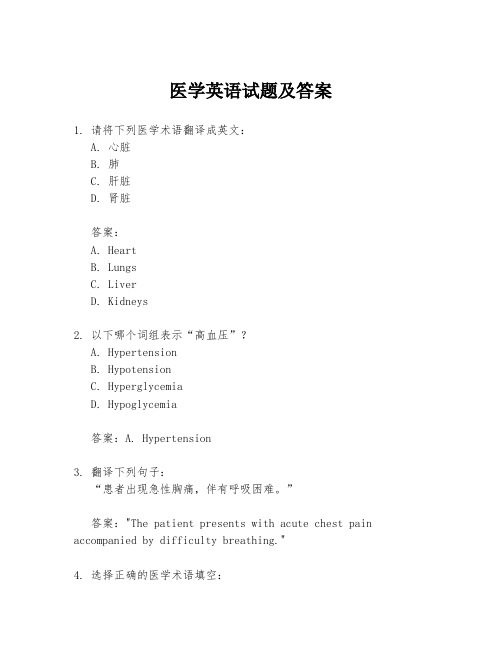
医学英语试题及答案1. 请将下列医学术语翻译成英文:A. 心脏B. 肺C. 肝脏D. 肾脏答案:A. HeartB. LungsC. LiverD. Kidneys2. 以下哪个词组表示“高血压”?A. HypertensionB. HypotensionC. HyperglycemiaD. Hypoglycemia答案:A. Hypertension3. 翻译下列句子:“患者出现急性胸痛,伴有呼吸困难。
”答案:"The patient presents with acute chest pain accompanied by difficulty breathing."4. 选择正确的医学术语填空:A. DiabetesB. HypertensionC. HypothyroidismD. Anemia他被诊断为一种慢性疾病,需要终身服用药物来控制血压。
答案:B. Hypertension5. 请解释“Cardiopulmonary Resuscitation (CPR)”的含义。
答案:Cardiopulmonary Resuscitation (CPR) 是一种紧急医疗程序,用于在心脏骤停时恢复某人的呼吸和血液循环。
6. 将下列医学缩写翻译成完整的医学术语:A. MRIB. CTC. ECGD. MRI答案:A. Magnetic Resonance ImagingB. Computed TomographyC. ElectrocardiogramD. Magnetic Resonance Imaging (重复项,应替换为其他缩写)7. 阅读下列段落并回答问题:The patient was admitted to the hospital with a diagnosis of acute appendicitis. An emergency appendectomy was performed, and the patient is now recovering in the postoperative ward.问:患者接受了哪种紧急手术?答案:患者接受了紧急阑尾切除术。
医学英语试题及答案
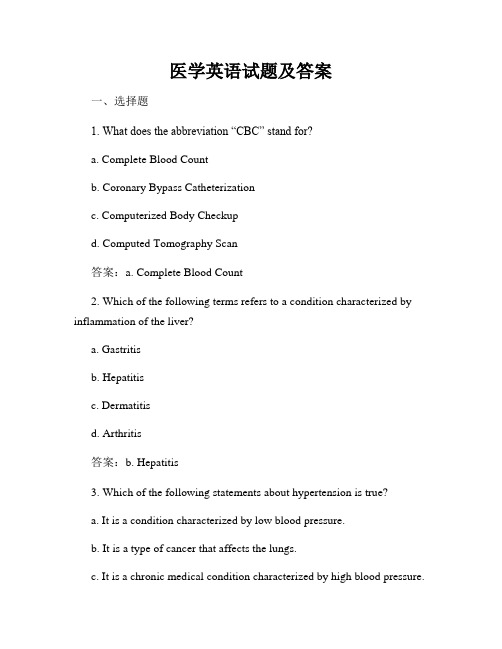
医学英语试题及答案一、选择题1. What does the abbreviation “CBC” stand for?a. Complete Blood Countb. Coronary Bypass Catheterizationc. Computerized Body Checkupd. Computed Tomography Scan答案:a. Complete Blood Count2. Which of the following terms refers to a condition characterized by inflammation of the liver?a. Gastritisb. Hepatitisc. Dermatitisd. Arthritis答案:b. Hepatitis3. Which of the following statements about hypertension is true?a. It is a condition characterized by low blood pressure.b. It is a type of cancer that affects the lungs.c. It is a chronic medical condition characterized by high blood pressure.d. It is an infectious disease caused by a bacterial infection.答案:c. It is a chronic medical condition characterized by high blood pressure.4. What does the abbreviation “MRI” stand for?a. Medical Respiratory Infectionb. Magnetic Resonance Imagingc. Myocardial Infarctiond. Malignant Renal Impairment答案:b. Magnetic Resonance Imaging5. Which of the following organs is responsible for filtering waste products from the blood?a. Liverb. Kidneyc. Stomachd. Lungs答案:b. Kidney二、填空题1. The study of cells is known as ________.答案:Cytology2. The branch of medicine that deals with the diagnosis and treatment of diseases of the heart and blood vessels is called ________.答案:Cardiology3. The largest organ in the human body is the ________.答案:Skin4. The condition characterized by the inability to see in dim light is called ________.答案:Night blindness5. The abbreviation COPD stands for ________.答案:Chronic Obstructive Pulmonary Disease三、简答题1. What is the function of red blood cells in the human body?答案:The function of red blood cells is to transport oxygen from the lungs to the body tissues and carry carbon dioxide back to the lungs for elimination.2. Define the term "antibiotic resistance."答案:Antibiotic resistance refers to the ability of bacteria or other microorganisms to resist the effects of antibiotics, making them ineffective in treating infections caused by these resistant organisms.3. What are the symptoms of a heart attack?答案:The symptoms of a heart attack may include chest pain or discomfort, shortness of breath, pain or discomfort in the arms, jaw, neck, or back, nausea, lightheadedness, and cold sweats.4. Name three ways to prevent the spread of infectious diseases.答案:Three ways to prevent the spread of infectious diseases are proper hand hygiene (such as washing hands with soap and water or using hand sanitizer), covering the mouth and nose when coughing or sneezing, and getting vaccinated.5. What are the four main types of tissue in the human body?答案:The four main types of tissue in the human body are epithelial tissue, connective tissue, muscle tissue, and nervous tissue.四、解释题1. Explain the concept of "herd immunity."答案:Herd immunity refers to a situation where a large proportion of a population is immune to a particular infectious disease, either through vaccination or previous exposure to the disease. When a significant portion of the population is immune, it reduces the likelihood of the disease being transmitted to individuals who are not immune, thus providing indirect protection to the entire community.2. What is the difference between a virus and a bacteria?答案:The main difference between a virus and a bacteria is that viruses are considered non-living entities that require a host cell to replicate, whilebacteria are single-celled microorganisms capable of reproducing on their own. Additionally, bacteria can be treated with antibiotics, whereas viruses cannot.3. Describe the process of mitosis.答案:Mitosis is a type of cell division that occurs in somatic cells and results in the formation of two genetically identical daughter cells. The process involves several stages, including prophase (chromosomes condense and become visible), metaphase (chromosomes align in the middle of the cell), anaphase (chromosomes separate and move to opposite poles), and telophase (nuclear membranes form around the separated chromosomes, and the cell divides).4. What is the purpose of an ECG (electrocardiogram)?答案:An ECG is a medical test that measures the electrical activity of the heart. It is used to diagnose and monitor various heart conditions, such as arrhythmias, heart attacks, and abnormalities in heart structure. The test records the electrical signals produced by the heart and displays them as a waveform on a graph, allowing healthcare professionals to evaluate the heart's rhythm and function.5. Define the term "acute respiratory distress syndrome (ARDS)."答案:Acute respiratory distress syndrome (ARDS) is a severe lung condition characterized by inflammation and fluid buildup in the lungs, leading to difficulty breathing and low blood oxygen levels. It is often caused by underlying conditions, such as pneumonia or sepsis, and can resultin respiratory failure. Treatment typically involves supportive care, such as mechanical ventilation, and addressing the underlying cause.以上为医学英语试题及答案的内容。
口腔科学习题
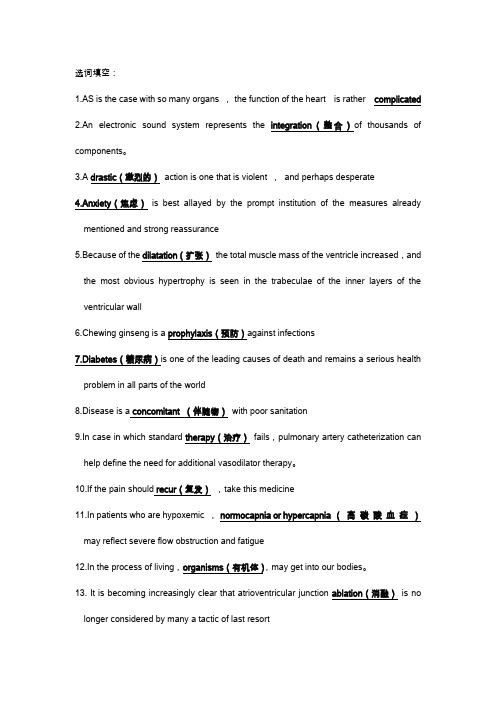
选词填空:1.AS is the case with so many organs ,the function of the heart is rather complicated2.An electronic sound system represents the integration(整合)of thousands of components。
3.A drastic(激烈的)action is one that is violent ,and perhaps desperate4.Anxiety(焦虑)is best allayed by the prompt institution of the measures already mentioned and strong reassurance5.Because of the dilatation(扩张)the total muscle mass of the ventricle increased,and the most obvious hypertrophy is seen in the trabeculae of the inner layers of the ventricular wall6.Chewing ginseng is a prophylaxis(预防)against infections7.Diabetes(糖尿病)is one of the leading causes of death and remains a serious health problem in all parts of the world8.Disease is a concomitant (伴随物)with poor sanitation9.In case in which standard therapy(治疗)fails,pulmonary artery catheterization can help define the need for additional vasodilator therapy。
高三英语医学用语单选题30题答案解析版

高三英语医学用语单选题30题答案解析版1.The patient has a high fever and a severe headache. What might be the possible cause?A.ColdB.FluC.AllergyD.Stress答案:B。
选项A“Cold”通常指普通感冒,症状可能有流鼻涕、轻微咳嗽等,但一般不会有高热和严重头痛。
选项B“Flu”即流感,常有高热、头痛、肌肉酸痛等症状,符合题目描述。
选项C“Allergy”过敏通常表现为皮疹、瘙痒、打喷嚏等,一般不会有高热和严重头痛。
选项D“Stress”压力可能导致焦虑、失眠等,但不会直接引起高热和严重头痛。
2.The doctor diagnosed the patient with a chronic disease. What does “chronic” mean?A.SeriousB.Long-termC.InfectiousD.Acute答案:B。
选项A“Serious”表示严重的。
选项B“Long-term”长期的,“chronic”就是指慢性的、长期的。
选项C“Infectious”有传染性的。
选项D“Acute”急性的。
3.The patient is suffering from a heart condition. Which of the following symptoms might they experience?A.DizzinessB.CoughC.FeverD.Nausea答案:A。
选项A“Dizziness”头晕,心脏有问题可能导致供血不足引起头晕。
选项B“Cough”咳嗽一般不是心脏问题的主要症状。
选项C“Fever”发热通常与感染等有关,不是心脏问题常见症状。
选项D“Nausea”恶心也不是心脏问题的典型症状。
4.The doctor prescribed some medicine for the patient. What does “prescribe” mean?A.BuyB.TakeC.RecommendD.Order答案:D。
中医英语基础试题及答案
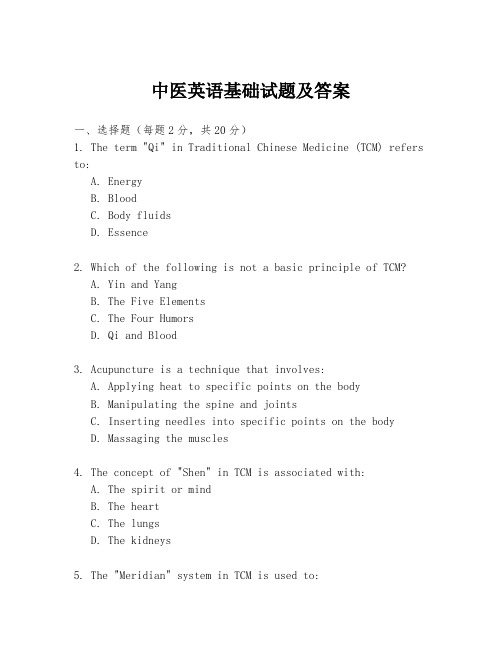
中医英语基础试题及答案一、选择题(每题2分,共20分)1. The term "Qi" in Traditional Chinese Medicine (TCM) refers to:A. EnergyB. BloodC. Body fluidsD. Essence2. Which of the following is not a basic principle of TCM?A. Yin and YangB. The Five ElementsC. The Four HumorsD. Qi and Blood3. Acupuncture is a technique that involves:A. Applying heat to specific points on the bodyB. Manipulating the spine and jointsC. Inserting needles into specific points on the bodyD. Massaging the muscles4. The concept of "Shen" in TCM is associated with:A. The spirit or mindB. The heartC. The lungsD. The kidneys5. The "Meridian" system in TCM is used to:A. Describe the flow of blood in the bodyB. Map the nervous systemC. Illustrate the pathways of Qi and blood throughout the bodyD. Outline the digestive system6. What is the primary goal of TCM treatment?A. To eliminate symptomsB. To restore balance and harmonyC. To cure the disease completelyD. To prolong life7. The TCM concept of "Wei Qi" refers to:A. Defensive energyB. Nutritive energyC. Vital energyD. Emotional energy8. Moxibustion is a TCM technique that involves:A. Burning herbs on the skinB. Applying cold compresses to the bodyC. Using heat from burning mugwort to warm acupuncture pointsD. Applying pressure to specific points on the body9. In TCM, "Dampness" is considered to be:A. A healthy stateB. An excess conditionC. A deficiency conditionD. A normal bodily function10. The TCM practice of "Diet Therapy" is based on theprinciple that:A. All foods have medicinal propertiesB. Food should be avoided when sickC. Only certain foods should be consumed for specific diseasesD. Diet has no impact on health答案:1. A2. C3. C4. A5. C6. B7. A8. C9. B 10. A二、填空题(每空1分,共10分)11. The fundamental substances of TCM include Qi, ______, and Jing.12. The TCM diagnostic methods are known as the Four Pillars, which are inspection, auscultation and olfaction, inquiry,and ______.13. In TCM, the spleen is associated with the element ______, and the liver with the element wood.14. The TCM treatment principle of "Treat the root before the branch" means that the underlying cause of the disease should be addressed before ______.15. The TCM concept of "Zang-Fang Organs" includes the heart, lung, spleen, liver, kidney, and ______.16. TCM believes that emotions can affect health, for example, excessive joy can injure the ______.17. The TCM technique of cupping involves creating a vacuum inside cups placed on the skin to ______.18. The TCM concept of "Jing Mai" refers to the pathways that nourish the ______.19. The TCM practice of "Tui Na" is a form of ______ massage.20. TCM emphasizes the importance of lifestyle and environment in maintaining health, which is known as the concept of ______.答案:11. Blood 12. palpation 13. earth 14. treating the symptoms 15. gallbladder 16. heart 17. draw out toxins 18. brain 19. therapeutic 20. Wei Qi三、简答题(每题5分,共20分)21. 简述中医的“五行”理论。
《医学英语》医学词汇课后练习题.doc
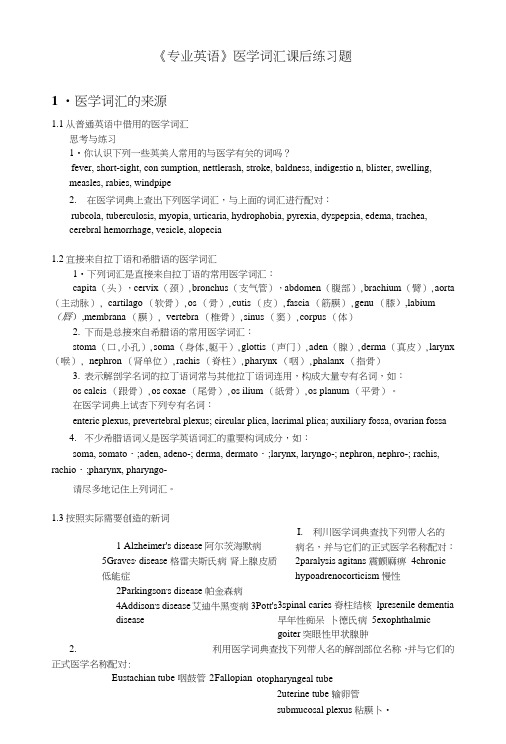
《专业英语》医学词汇课后练习题1 •医学词汇的来源1.1从普通英语中借用的医学词汇思考与练习1•你认识下列一些英美人常用的与医学有关的词吗?fever, short-sight, con sumption, nettlerash, stroke, baldness, indigestio n, blister, swelling, measles, rabies, windpipe2. 在医学词典上查出下列医学词汇,与上面的词汇进行配对:rubcola, tuberculosis, myopia, urticaria, hydrophobia, pyrexia, dyspepsia, edema, trachea, cerebral hemorrhage, vesicle, alopecia1.2宜接来自拉丁语和希腊语的医学词汇1•下列词汇是直接来自拉丁语的常用医学词汇:capita (头),cervix (颈),bronchus (支气管),abdomen (腹部),brachium (臂),aorta (主动脉), cartilago (软骨),os (骨),cutis (皮),fascia (筋膜),genu (膝),labium (唇),membrana (膜), vertebra (椎骨),sinus (窦),corpus (体)2. 下而是总接來自希腊语的常用医学词汇:stoma (口,小孔),soma (身体,躯干),glottis (声门),aden (腺),derma (真皮),larynx (喉), nephron (肾单位),rachis (脊柱),pharynx (咽),phalanx (指骨)3. 表示解剖学名词的拉丁语词常与其他拉丁语词连用,构成大量专有名词,如: os calcis (跟骨),os coxae (尾骨),os ilium (紙骨),os planum (平骨)。
基础医学英语术语复习题

基础医学英语术语复习题集团文件版本号:(M928-T898-M248-WU2669-I2896-DQ586-M1988)基础医学英语术语复习题1. cyto meansA. fatB.smoothC. blue B. cell2. myo- refers to your:A. brainmyoptic nervefeetmuscle3. neuro means:nervenewdigestive systemendocrine system4. kary/o meanscellkaraokenucleusillness5. leuk/o means:whitelimpidblacksickle-shaped6. erythro/o means:membraneheart-shapedredbrown7. histo/o means:filmtimetissueyellow8. melano means:blackdiseasedmalignantcancer9. path/o means:withinpurpleexciseddisease10. somat/o means:extremitybodytissuenerve11. Endo means:Above.Below.Within.Fat.12. Thromb/o means:To throb.To divide.To clot.To dry out.13. Brady- means:Fast.Irregular.Prolonged.Slow.14. Salping/o means .Fallopian tube.Pus.Polyp.Flesh, connective tissue.15. Onych/o meansTesticle.The same as Orchi/o.Single, one.Nail.16. Tachy- (as in tachycardia) means:A slowing downIrregularFast or rapidMalignant17. andro means: above, overhumanthroughmale18. viscer/o means: cut openinternal organs exoskeletonrelate to19. cyanobluewhitecyanidelarge20. gno/o means: smallknowledgescience ofbranch21. onc/o means:oldcancertumordeadly22. iatr/o means: hirsuteiodinephysician, medicine cold23. lip/o:whitefatroughsoft24. xantho means: yellowbrownantireversed25. eti/o (as in etiology): systemscience ofcausehistory26. dys- means:twodifficulteasyforked27. hypo- means:below, incompleteover, outsidethroughinside, within28. chrom/o means:silvercolorbrittleshiny29. rhabd/o means:rod-shapedscience ofrapidhistory30. sarco means:flesh, connective tissue solidopaqueforked31. -emia means:Blood Condition.Deficiency.Excess of.Death of32. -pnea means :Break.Breathing.Swallowing.Circulation.33. -stenosis means:Hardening.Constriction.Expanding.Malignancy.34. -ostomy means:Cut into or incision.Ablation.Enlargement.Create an artificial opening.35. -otomy means:Cut into or incision.Ablation.Enlargement.Create an artificial opening.36. -megaly means:Multiply.Ablation.Enlargement.Diseased.37. -plasia means:Formation, development or growth. Repairing of, suturing.Metastisizing of a tumor.Condition.38. -cele means:Cell.Chest.Cavity.Swelling, protrusion.39. -itis means:Itching.Burning.Scaly.Inflammation.40. The Suffix "pepsia" refers to: Chest musclesThe nervous systemDigestionHearing41. Scraping away of the skin or mucous membrane by friction. ContusionAbrasionCarbuncleBullae42. Surgical repair of the cornea.KeratonomyCorneoplastyKeratoplastyKeratoscopy43. Inflammation of the tympanic membrane.AnotiaLabyrinthitisMeniere's diseaseMyringitis44. Bluish discoloration of the skin.CyanosisEdemaCiliumEffusion45. Disease of the heart muscle.CardioplexyCardiopathyCardiomyopathyMyopathy46. Removal of the gallbladder.CystectomyCholedochectomyCholecystectomyCholangiography47. Painful menstruation.AmenorrheaHypermenorrheaDyspareuniaDysmenorrhea48. Above the pubic bones.PerineumTransperinealInferiopubicSuprapubic49. Enlargement of a finger or toe. DactylomegalyAnkylosisDiaphysisKyphosis50. The medical term for headache. CephalgiaCyanosisMigraineConcussion51. Red blood cell.LymphocyteEosinophilLeukocyteErythrocyte52. An infection with the fungus Candida. ThrushMacrophageTiterImpetigo53. Disease of a lymph node.LymphadenopathyAdenoidopathyAdenectomyAdenitis54. A woman who has never been pregnant. NulligravidaPrimigravidaNulliparaPrimipara55. Accumulation of blood in a joint. HemarthrosisHematuriaHematosisHepatitis56. Protrusion of the eyeballs.ExophthalmosOphthalmusExotropiaOpacification57. Abnormal widening of the bronchi.BronchiolitisBronchiectasisBronchiolvescularAsthma58. Membranes that cover the brain and spinal cord.MeningesCerebrospinal fluidMeningitisMyasthenia59. An agent that causes disease.PhagocyteProteaseProphylaxisPathogen60. Blood in the urine.UremiaHematocritHeomstasisHematuria61. Erythrocytes are:White blood cells.Red blood cells.Benign tumor cells.Also known as Leukocytes.62. The superior vena cava is:The major artery that supplies the trunk and legs with blood. Located in the lower trunk of the body.Located in the lower part of the neck..Connected to the celiac trunk.63. The common carotid artery is:In the upper portion of the thigh.Beneath the Medulla OblongataAt the base of the neck.Inside the Cerebellum64. The carotid artery branches into the:Internal carotid artery; the external carotid artery.Supratrochlear, supertrochlear..Inferior thoracic, superior thoracic.Common iliac artery, external iliac artery..65. The integumentary system does NOT include the:Liver.Hair.Nails.Mouth.66. The right ventricle is the:One of the primary heart valves.Large lower cavity of the heart.Left upper portion of the heart..Right upper portion of the heart67. The septum:Divides the heart lengthwise into left and right.separates the right and left nasal cavity.The thin wall which separates one alveolus from another.All of the above.68. The cervical lymph nodes are located:Near the groin.In the armpit.Near the stomach.In the neck.69. Inguinal means:Near the heart.In the groin area.The region of the small intestines.The lower leg.70. Axillary lymph glands are located:In the neck.In the groin.In the upper leg.In the armpit.71. A bronchoplasty is the surgical repair of the bronchus. TrueFalse72. A fistula is tube-like passage between two organs, for example, between the kidney and an organ of the digestive system.TrueFalse73. A sigmoidoscopy is an endoscopic examination of a part of the small intestines.TrueFalse74. The term percutaneous is derived from the greek "to cut a (small) incision (through the skin)"TrueFalse75. Ablation refers to the procedure of expanding a vessel (e.g., an artery) using a balloon.TrueFalse76. A Laryngostomy is a surgical incision (opening) from the neckinto the larynx.TrueFalse77. Ablution means to destroy or remove.TrueFalse78. A neurorrhaphy is the separating of a blood vessel.TrueFalse79. Osteoclasis is the surgical breaking of a bone.TrueFalse80. Costectomy is the surgical repair of the coccyx.TrueFalseMatching: Matching the terms in each of following sets with their definitions and write the appropriate letter (a-e) to the left of each number:1. bilateral a. compound made of many subunits2. hemiplegia b. paralysis of one side of the body3. Quadrisect c. Partial state of unconsciousness4. polymer d. pertaining to both sides of thebody5. semicoma e. cut into four parts6. melanocyte a. scanty menstrual flow7. leukoderma b. loss of color in the skin8. xanthoocyte c. dark-colored cell9. adhesion d. cell with yellow color10. oligomenorrhea e. attachment of parts11. sinistral a. parasite that lives inside thebody12. ectoparasite b. toward the left13. endoparasite c. endbrain14. mesencephalon d. parasite that lives outside of thebody______15. telencephalon e. midbrain____________16. cytoplasm a. organelles that manufacture energyfrom food______17. DNA b. organelles that manufactureprotein______18. TP c. genetic material______19. ribosomes d. energy compound of the cell______20. mitochondria e. fluid that fills the cell______21. homeostasis a. building phase of metabolism______22. catabolism b. state of internal stability______23. anabolism c. fibrous protein in connectivetissueCase Studies1. Esopha’geal spasm 食道痉挛This patient is a 53-year-old white female who has consulted for occasional episodes of dysphagia(吞咽困难) with moderate to severe tight, gripping pain in the mid-thorax. The onset is suddenfollowing ingestion of food or beverage. The pain is retrosternal (胸骨后的) at first and then radiates to the cervical and dorsal regions. It is not improved by assuming a supine position(仰卧).There is no vomiting or dyspnea(呼吸困难). In the absence of other symptoms, esophageal spasm is suspected. If difficulties persist, fluoroscopy(荧光检查)with a barium9(钡)swallow will be done torule out paraesophageal hiatal hernia.(食管旁食管旁裂孔疝)2. Pathology report-Cervical and Endometrial BiopsiesTwo separate uterine(子宫的) specimens are submitted. Specimen 1 is a cervical biopsy(宫颈活检)1.3cm in maximum width by 1.1 cm thickness. The exocervical (外子宫颈的) surface is smooth. There are numerous areas of mild to moderate dysplasia(发育异常). SlideF shows the endocervix(宫颈内膜 ) displaying metaplasia byhyperchromatic cells() involving almost the entire thickness of the epithelium. No area of invasion of the basement is observed.There is chronic inflammation(慢性炎症). Specimen 2 consists of multiple fragments of endometrial tissue. Examination show aproliferative(增生性的 ) type of endometrium(子宫内膜). Nomalignancy is seen.3. Laparoscopy(腹腔镜检查)and laparotomy(剖腹手术)The patient was taken to the operating room under general anesthetic. A pneumoperitoneum (气腹) was performed for usuallaparoscopy procedure per an infraumbilical (脐下的) incision.Visualization(造影,显影) of the abdominal viscera(内脏) wascomplicated by multiple small bowel (小肠)adhesions. Thelaparoscopy instruments were therefore withdrawn. Interrupted 3.0 Vicryl sutures(缝合线) were placed periumbilically(脐周的). An exploratory laparotomy (剖腹探查术)was then performed by means ofa midline incision.81. The term supine meansA. lying face downB. standing in the anatomic positionC. sittingD. lying face up82. The cervical region is the region of theA. heartB. armC. neckD. head83. A word that means the same as dorsal isA. anteriorB. inferiorC. posteriorD. superior84. the terms metaplasia and dysplasia refer toA. formation of cellsB. numbers of cellsC. size of cellsD. color of cells85. The phrase “adhesion were lysed” means thatA. parts were joined togetherB. joined parts were separatedC. parts were removedD. specimens were taken86. The term hyperchromatic meansA. excessively large in sizeB. excessively small in sizeC. deficient in colorD. containing excess color87. The term pneumoperitoneum refers toA. inflation of the thoracic cavityB. incision of the abdominal cavityC. inflation of the abdominal cavityD. incision of the pleural cavity。
医学专业英语考试专题 (含答案)
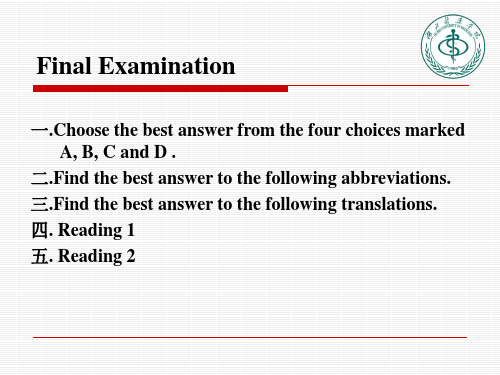
D19. Which of the following does not mean “with in or in”? A. enB. endo C. intraD. none of the above C20. _______ means surgical repair of an organ. A. phag/o B. –plasm C. –plasty D. –pathy C21. Spir/o is a combining form meaning ______. A. see B. sight C. breath D. sport
C25.Which of the following combining forms does not re fer to an organ? A. hepat/o B. gastr/o C. psych/o D. neph r/o D26. The color of something best expressed in medical te rminology is _______. A. chrom/o B. chromomat/o C. chramat/o D. Both A and B C27. Which of the following means “instrument for mea suring”? A. -graph B. -tome C. –meter D. -scope
I. Choose the best answer from the four cho ices marked A, B, C and D.
m D1. Which of the following suffixes does not mean “pertaining to”? A. -ic B. -al C. -ar D. -our B2. Which of the following combining forms me ans cell? A. -cyte B. cyt/o C. cel/o D. both a and b C3. Which of the following forms means tissue? A. erythr/o B. immun/o C.hist/o D. vas cul/o
医学英语往年试题及答案

医学英语往年试题及答案一、选择题(每题2分,共20分)1. The term "cardiology" refers to the study of which organ?A. HeartB. LungsC. LiverD. Kidneys2. Which of the following is not a type of diabetes?A. Type 1 diabetesB. Type 2 diabetesC. Gestational diabetesD. Type 4 diabetes3. The abbreviation "MRI" stands for:A. Magnetic Resonance ImagingB. Medical Research InstituteC. Multiple Risk IndicatorsD. Major Radiological Intervention4. In medical terms, "anemia" is a condition characterized by:A. High blood pressureB. Low blood sugarC. Low red blood cell count or low hemoglobinD. High cholesterol levels5. The term "pneumonia" is associated with an infection of which organ?A. HeartB. LungsC. StomachD. Brain6. Which of the following is a common symptom of the common cold?A. DiarrheaB. RashC. CoughD. Jaundice7. The medical abbreviation "OTC" stands for:A. Over the CounterB. Outpatient Treatment CenterC. Occupational Therapy CenterD. Oral Treatment Course8. A "biopsy" is a medical procedure to:A. Remove a sample of tissue for examinationB. Administer medicationC. Perform surgery to remove a tumorD. Examine the blood under a microscope9. The term "epidemic" refers to:A. A sudden increase in the number of cases of a diseaseB. A disease that is present in a communityC. A disease that is endemic to a particular areaD. A disease that has been eradicated10. The abbreviation "HIV" stands for:A. Human Immunodeficiency VirusB. Highly Infectious VirusC. Hepatitis Infection VirusD. Hemophiliac Immune Virus答案:1-5: A, D, A, C, B6-10: C, A, A, A, A二、填空题(每空1分,共10分)1. The medical term for inflammation of the lungs is__________.2. A __________ is a healthcare professional who specializes in the diagnosis and treatment of diseases and injuries of the musculoskeletal system.3. The abbreviation "AIDS" stands for Acquired Immune Deficiency __________.4. The process of medical imaging that uses X-rays to create images of the inside of the body is called __________.5. A __________ is a surgical procedure to remove a diseased or damaged organ or tissue.答案:1. Pneumonitis2. Orthopedist3. Syndrome4. Radiography5. Excision三、简答题(每题5分,共20分)1. What is the difference between a virus and a bacterium?2. Explain the concept of "herd immunity" in the context of public health.3. What is the role of white blood cells in the immune system?4. Describe the function of the thyroid gland.答案:1. A virus is a small infectious agent that can onlyreplicate inside the living cells of an organism, while a bacterium is a single-celled microorganism that can live independently and reproduce by binary fission.2. Herd immunity occurs when a large percentage of apopulation has become immune to an infection, therebyproviding a measure of protection for individuals who are not immune.3. White blood cells play a critical role in defending the body against both infectious disease and foreign invaders. They help to fight off infections by identifying, attacking, and eliminating pathogens.4. The thyroid gland is a butterfly-shaped gland located inthe neck that produces hormones which regulate the body's metabolism, growth, and development.四、翻译题(每题5分,共15分)1. 请将“慢性阻塞性肺病”翻译成英文。
医学英语考试试题及答案

医学英语考试试题及答案一、选择题(每题1分,共10分)1. Which of the following is a common symptom of the common cold?A. FeverB. CoughC. Both A and BD. Neither A nor B2. The term "cardiology" refers to the study of which organ?A. LiverB. HeartC. LungsD. Kidneys3. What does the abbreviation "MRI" stand for?A. Magnetic Resonance ImagingB. Medical Research InstituteC. Multiple Response IndicatorD. Medical Radiology Institute4. The process of healing a wound is known as:A. InflammationB. RegenerationC. ResectionD. Reabsorption5. Which of the following is not a type of cancer?A. LeukemiaB. MelanomaC. SarcomaD. Fibromyalgia6. The term "diabetes" is related to the body's inability to:A. Excrete wasteB. Regulate blood sugar levelsC. Maintain body temperatureD. Clot blood7. The abbreviation "HIV" stands for:A. Human Immunodeficiency VirusB. High Intensity VirusC. Hemorrhagic Influenza VirusD. Hepatitis Infection Virus8. A "pathogen" is an agent that can cause:A. DiseaseB. GrowthC. RegenerationD. Immunity9. The medical term "anemia" refers to a deficiency of:A. CalciumB. IronC. Vitamin CD. Potassium10. The abbreviation "WHO" stands for:A. World Health OrganizationB. World Health OrganizationalC. World Health OperationsD. World Health Oversight答案:1. C2. B3. A4. B5. D6. B7. A8. A9. B10. A二、填空题(每空1分,共10分)1. The medical term for inflammation of the lungs is ______.答案:Pneumonia2. A person with a condition that causes excessive thirst and urination is said to have ______.答案:Diabetes3. The study of the nervous system is known as ______.答案:Neurology4. A surgical procedure to remove a diseased organ is called a/an ______.答案:Resection5. The process by which the body destroys and removes waste and foreign substances is called ______.答案:Immunity6. A medical condition characterized by high levels of fat in the blood is known as ______.答案:Hyperlipidemia7. The abbreviation for the medical term "arteriosclerosis" is ______.答案:AS8. A deficiency in the number or quality of red blood cells is referred to as ______.答案:Anemia9. The medical term for the surgical removal of a tumor is______.答案:Excision10. The study of the structure and function of the human body is called ______.答案:Anatomy三、简答题(每题5分,共20分)1. What is the difference between a virus and a bacterium?答案:A virus is a small infectious agent that can only replicate inside the living cells of an organism, while a bacterium is a single-celled microorganism that can live independently and reproduce by binary fission.2. Explain the concept of "homeostasis" in the body.答案:Homeostasis refers to the ability of an organism to maintain a constant internal environment despite changes in external conditions. This includes the regulation of body temperature, pH, and chemical composition to ensure optimal functioning of cells and organs.3. What is the role of the thyroid gland in the body?答案:The thyroid gland is an endocrine gland that produces hormones, such as thyroxine (T4) andtriiodothyronine (T3), which regulate the body's metabolism, growth, and development.4. Describe the function of the respiratory system.答案:The respiratory system is responsible for the exchange of gases, primarily oxygen and carbon dioxide, between the body and the environment. It includes the process of inhalation, where oxygen is taken in, and exhalation, where carbon dioxide is expelled.四、翻译题(每题5分,共20分)1. 请将以下医学术语翻译成中文:"Cardiopulmonary resuscitation"答案:心肺复苏2. 请将。
中医英语基础试题及答案
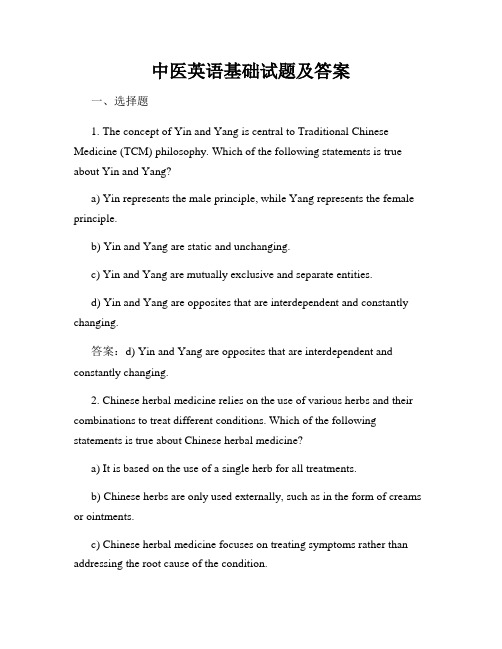
中医英语基础试题及答案一、选择题1. The concept of Yin and Yang is central to Traditional Chinese Medicine (TCM) philosophy. Which of the following statements is true about Yin and Yang?a) Yin represents the male principle, while Yang represents the female principle.b) Yin and Yang are static and unchanging.c) Yin and Yang are mutually exclusive and separate entities.d) Yin and Yang are opposites that are interdependent and constantly changing.答案:d) Yin and Yang are opposites that are interdependent and constantly changing.2. Chinese herbal medicine relies on the use of various herbs and their combinations to treat different conditions. Which of the following statements is true about Chinese herbal medicine?a) It is based on the use of a single herb for all treatments.b) Chinese herbs are only used externally, such as in the form of creams or ointments.c) Chinese herbal medicine focuses on treating symptoms rather than addressing the root cause of the condition.d) Chinese herbal medicine aims to restore balance and harmony within the body.答案:d) Chinese herbal medicine aims to restore balance and harmony within the body.3. Acupuncture is a widely used treatment in Chinese medicine. What is the primary method used in acupuncture?a) Herbal remediesb) Massage techniquesc) Stimulation of specific points on the body with fine needlesd) Meditation and breathing exercises答案:c) Stimulation of specific points on the body with fine needles4. Tui Na is a form of Chinese therapeutic massage. What is the main purpose of Tui Na?a) To relax the body and relieve stressb) To diagnose illnesses through touchc) To treat specific conditions by manipulating the body's energyd) To improve flexibility and joint mobility答案:c) To treat specific conditions by manipulating the body's energy二、填空题1. The meridian system, also known as _________ in Chinese medicine, is a network of pathways through which Qi flows.答案:Jing Luo2. The four diagnostic methods in Chinese medicine are observation,_______, questioning, and listening and smelling.答案:palpation3. The concept of "qi" is often translated as _______.答案:vital energy4. In TCM, the five elements theory categorizes substances and organs into five elements: Wood, Fire, Earth, _______, and Metal.答案:Water三、简答题请用英文回答以下问题:1. What is the underlying principle of Traditional Chinese Medicine?答案:Traditional Chinese Medicine is based on the principle that the body's vital energy, known as "qi," flows through channels called meridians. When the flow of qi is balanced and unobstructed, a person is considered to be in good health. Any disruption or blockage in the flow of qi is believed to cause illness or disease.2. What are the main treatment modalities in Traditional Chinese Medicine?答案:The main treatment modalities in Traditional Chinese Medicine include acupuncture, herbal medicine, Tui Na massage, and Qi Gong exercises. Acupuncture involves the insertion of fine needles at specific points on the body to stimulate the flow of qi and restore balance. Chinese herbal medicine uses a combination of herbs to address specific health conditions. Tui Na massage manipulates the body's energy to treat various conditions, and Qi Gong exercises promote the flow of qi through physical movements, meditation, and breathing techniques.3. How does Traditional Chinese Medicine differ from Western medicine?答案:Traditional Chinese Medicine takes a holistic approach to health, focusing on balancing the body's energy and addressing the root cause of the illness, rather than just treating symptoms. It also emphasizes the importance of prevention and maintaining overall well-being. In contrast, Western medicine tends to focus on diagnosing and treating specific symptoms or diseases through medications and surgeries. Western medicine often relies on scientific evidence and clinical trials, while Traditional Chinese Medicine draws on thousands of years of empirical knowledge and observation.总结:本文介绍了中医英语基础试题及答案,包括选择题、填空题和简答题。
医学英语试题及答案
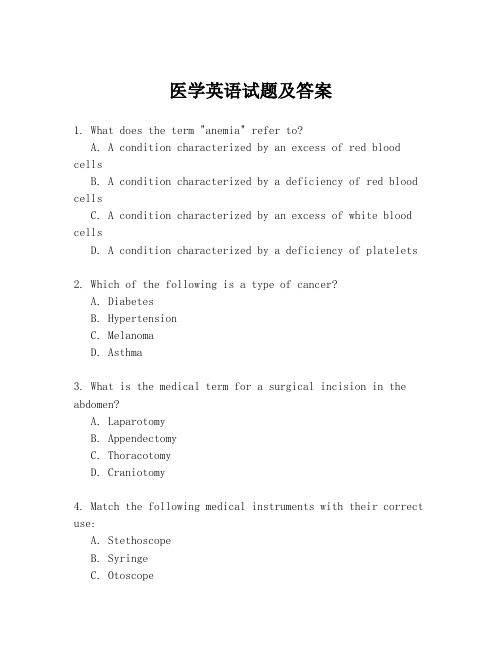
医学英语试题及答案1. What does the term "anemia" refer to?A. A condition characterized by an excess of red blood cellsB. A condition characterized by a deficiency of red blood cellsC. A condition characterized by an excess of white blood cellsD. A condition characterized by a deficiency of platelets2. Which of the following is a type of cancer?A. DiabetesB. HypertensionC. MelanomaD. Asthma3. What is the medical term for a surgical incision in the abdomen?A. LaparotomyB. AppendectomyC. ThoracotomyD. Craniotomy4. Match the following medical instruments with their correct use:A. StethoscopeB. SyringeC. OtoscopeD. Sphygmomanometera. Measuring blood pressureb. Listening to heart and lung soundsc. Injecting medication or drawing fluidd. Examining the ear canal5. What is the abbreviation for "Magnetic Resonance Imaging"?A. CTB. MRIC. X-rayD. PET6. Translate the following medical term from English to Chinese:"Cardiomyopathy" - 心肌病7. What does the term "hyperglycemia" mean?A. High blood sugar levelsB. Low blood sugar levelsC. High blood pressureD. Low blood pressure8. Which of the following is a common symptom of the common cold?A. JaundiceB. RashC. CoughD. Hematuria9. What is the medical term for a condition where the body's immune system attacks its own tissues?A. AllergyB. Autoimmune diseaseC. InfectionD. Tumor10. What does the term "antibiotic" refer to?A. A medication used to treat bacterial infectionsB. A medication used to treat viral infectionsC. A medication used to treat fungal infectionsD. A medication used to treat parasitic infections答案1. B. Anemia is a condition characterized by a deficiency of red blood cells.2. C. Melanoma is a type of skin cancer.3. A. Laparotomy is the medical term for a surgical incision in the abdomen.4. A - b, B - c, C - d, D - a (Stethoscope is used for listening to heart and lung sounds, Syringe for injecting medication or drawing fluid, Otoscope for examining the ear canal, Sphygmomanometer for measuring blood pressure.)5. B. MRI stands for Magnetic Resonance Imaging.6. "Cardiomyopathy" translates to 心肌病 in Chinese.7. A. Hyperglycemia means high blood sugar levels.8. C. Cough is a common symptom of the common cold.9. B. Autoimmune disease is a condition where the body's immune system attacks its own tissues.10. A. Antibiotic refers to a medication used to treat bacterial infections.这套试题覆盖了医学英语中的一些基本术语和概念,通过练习这些问题,可以帮助学习者更好地理解和应用医学英语。
基础医学英语术语复习题
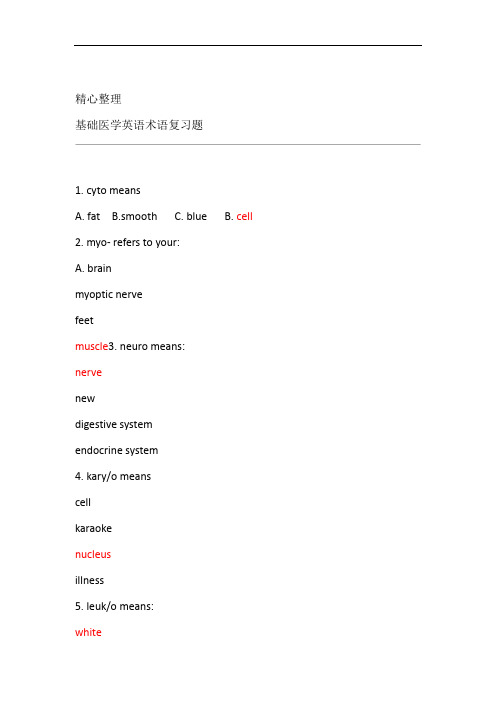
精心整理基础医学英语术语复习题1. cyto meansA. fatB.smoothC. blue B. cell2. myo- refers to your:A. brainmyoptic nervefeetmuscle3. neuro means:nervenewdigestive systemendocrine system4. kary/o meanscellkaraokenucleusillness5. leuk/o means:whiteblacksickle-shaped6. erythro/o means: membraneheart-shapedredbrown7. histo/o means: filmtimetissueyellow8. melano means: blackdiseased malignant精心整理.精心整理cancer9. path/o means: withinexciseddisease10. somat/o means: extremitybodytissuenerve11. Endo means: Above.Below.Within.Fat.Thromb/o means: 12. To throb.To divide..To clotTo dry out.13. Brady- means: Fast.Irregular. Prolonged.14. Salping/o means .. Fallopian tube Pus.Polyp.Flesh, connective tissue.15. Onych/o meansTesticle.The same as Orchi/o.Single, one.Nail.16. Tachy- (as in tachycardia) means:A slowing downIrregular精心整理.精心整理Fast or rapidMalignant17. andro means:above, overhumanthrough18. viscer/o means: cut openinternal organs exoskeletonrelate to19. cyanobluewhitecyanidelarge20. gno/o means: smallknowledge science ofbranch21. onc/o means: oldcancertumordeadly22. iatr/o means:iodinephysician, medicine cold23. lip/o:whitefatroughsoft24. xantho means: yellow精心整理.精心整理brownantireversed25. eti/o (as in etiology): systemscience ofcausehistory26. dys- means:twodifficulteasyforked27. hypo- means: below, incomplete over, outsidethroughinside, within28. chrom/o means: silvercolorbrittleshiny29. rhabd/o means: rod-shapedscience ofrapidhistory30. sarco means: flesh, connective tissue solidopaqueforked31. -emia means: Blood Condition. Deficiency. Excess of.Death of-pnea means : 32. 精心整理.精心整理Break. Breathing. Swallowing. Circulation.33. -stenosis means: Hardening. Constriction. Expanding. Malignancy.34. -ostomy means: Cut into or incision. Ablation.Enlargement.Create an artificial opening.35. -otomy means:Cut into or incision.Ablation.Enlargement.Create an artificial opening.36. -megaly means:Multiply.Ablation.Enlargement.Diseased.37. -plasia means:Formation, development or growth. Repairing of, suturing. Metastisizing of a tumor. Condition.38. -cele means:Cell.Chest.Cavity.Swelling, protrusion.39. -itis means:Itching.Burning.Scaly.Inflammation.精心整理.精心整理40. The Suffix pepsia refers to:Chest musclesThe nervous systemDigestionHearing41. Scraping away of the skin or mucous membrane by friction. ContusionAbrasionCarbuncleBullae42. Surgical repair of the cornea.KeratonomyCorneoplastyKeratoplastyKeratoscopy43. Inflammation of the tympanic membrane. AnotiaLabyrinthitisMeniere's diseaseMyringitis44. Bluish discoloration of the skin. CyanosisEdemaCiliumEffusion45. Disease of the heart muscle. CardioplexyCardiopathyCardiomyopathyMyopathy46. Removal of the gallbladder. CystectomyCholedochectomy Cholecystectomy Cholangiography47. Painful menstruation. Amenorrhea HypermenorrheaDyspareunia精心整理.精心整理Dysmenorrhea48. Above the pubic bones. PerineumTransperinealInferiopubicSuprapubic49. Enlargement of a finger or toe. DactylomegalyAnkylosisDiaphysisKyphosis50. The medical term for headache. CephalgiaCyanosisMigraineConcussion51. Red blood cell.LymphocyteEosinophilLeukocyteErythrocyte52. An infection with the fungus Candida. ThrushMacrophageTiterImpetigo53. Disease of a lymph node. LymphadenopathyAdenoidopathyAdenectomyAdenitis54. A woman who has never been pregnant. NulligravidaPrimigravidaNulliparaPrimipara55. Accumulation of blood in a joint. HemarthrosisHematuria精心整理.精心整理HematosisHepatitis56. Protrusion of the eyeballs.ExophthalmosOphthalmusExotropiaOpacification57. Abnormal widening of the bronchi. BronchiolitisBronchiectasisBronchiolvescularAsthma58. Membranes that cover the brain and spinal cord. MeningesCerebrospinal fluidMeningitisMyasthenia59. An agent that causes disease.PhagocyteProteaseProphylaxisPathogen60. Blood in the urine.UremiaHematocritHeomstasisHematuria61. Erythrocytes are:White blood cells.Red blood cells.Benign tumor cells.Also known as Leukocytes.62. The superior vena cava is:The major artery that supplies the trunk and legs with blood.Located in the lower trunk of the body.Located in the lower part of the neck.. Connected to the celiac trunk.63. The common carotid artery is:In the upper portion of the thigh.精心整理.精心整理Beneath the Medulla OblongataAt the base of the neck.Inside the Cerebellum64. The carotid artery branches into the:Internal carotid artery; the external carotid artery. Supratrochlear, supertrochlear..Inferior thoracic, superior thoracic.Common iliac artery, external iliac artery..65. The integumentary system does NOT include the: Liver.Hair.Nails.Mouth.66. The right ventricle is the:One of the primary heart valves.Large lower cavity of the heart.Left upper portion of the heart..Right upper portion of the heart67. The septum:Divides the heart lengthwise into left and right. separates the right and left nasal cavity.The thin wall which separates one alveolus from another. All of the above.68. The cervical lymph nodes are located:Near the groin.In the armpit.Near the stomach.In the neck.69. Inguinal means:Near the heart.In the groin area.The region of the small intestines.The lower leg.70. Axillary lymph glands are located:In the neck.In the groin.In the upper leg.In the armpit.A bronchoplasty is the surgical repair of the bronchus. 71.精心整理.精心整理TrueFalse72. A fistula is tube-like passage between two organs, for example, between the kidneyand an organ of the digestive system.TrueFalse73. A sigmoidoscopy is an endoscopic examination of a part of the small intestines.TrueFalse74. The term percutaneous is derived from the greek o cut a (small) incision (throughthe skin)TrueFalseusing a75. Ablation refers to the procedure of expanding a vessel (e.g., an artery)balloon.TrueFalse76. A Laryngostomy is a surgical incision (opening) from the neck into the larynx.TrueFalseAblution means to destroy or remove. 77.TrueFalse78. A neurorrhaphy is the separating of a blood vessel.TrueFalse79. Osteoclasis is the surgical breaking of a bone.TrueFalse80. Costectomy is the surgical repair of the coccyx.TrueFalseMatching: Matching the terms in each of following sets with their definitions and writethe appropriate letter (a-e) to the left of each number:1. bilateral a. compound made of many subunitsb. paralysis of one side of the body2. hemiplegia精心整理.精心整理3. Quadrisect c. Partial state of unconsciousnessd. pertaining to both sides of the body 4. polymere. cut into four parts 5. semicomaa. scanty menstrual flow 6. melanocyteb. loss of color in the skin 7. leukodermac. dark-colored cell8. xanthoocyted. cell with yellow color9. adhesione. attachment of parts10. oligomenorrheaa. parasite that lives inside the body11. sinistralb. toward the left12. ectoparasitec. endbrain13. endoparasited. parasite that lives outside of the body14. mesencephalone. midbrain 15. telencephalon ____________a. organelles that manufacture energy 16. cytoplasm ______ from foodb. organelles that manufacture protein 17. DNA ______c. genetic material______ 18. TPd. energy compound of the cell ______ 19. ribosomese. fluid that fills the cell ______ 20. mitochondriaa. building phase of metabolism ______ 21. homeostasisb. state of internal stability______ 22. catabolismc. fibrous protein in connective tissue ______ 23. anabolismd. breakdown phase of metabolism24. adipose______精心整理.精心整理精心整理.精心整理精心整理.精心整理Case Studies1. Esopha'geal spasm 食道痉挛精心整理.精心整理This patient is a 53-year-old white female who has consulted for occasionalepisodes of dysphagia(吞咽困难) with moderate to severe tight, gripping pain in themid-thorax. The onset is sudden following ingestion of food or beverage. The pain isretrosternal (胸骨后的) at first and then radiates to the cervical and dorsal regions. Itis not improved by assuming a supine position(仰卧). There is no vomiting ordyspnea(呼吸困难). In the absence of other symptoms, esophageal spasm issuspected. If difficulties persist, fluoroscopy(荧光检查)with abarium9(钡)swallow )will be done to rule out paraesophageal hiatal hernia.(食管旁食管旁裂孔疝2. Pathology report-Cervical and Endometrial Biopsies) specimens are submitted. Specimen 1 is a cervical 子宫的Two separate uterine(1.3cm in maximum width by 1.1 cm thickness. The exocervical biops(宫颈活检) surface is smooth. There are numerous areas of mild to moderate子宫颈) displaying metaplasia). Slide F shows the endocervix宫颈内dysplasia发育异) involving almost the entire thickness of the高染色细by hyperchromatic cellsepithelium. No area of invasion of the basement is observed. There is chronic). Specimen 2 consists of multiple fragments of endometrial慢性炎inflammation子宫) type of endometrium增生性tissue. Examination show a proliferative). No malignancy is seen.))and laparotomy剖腹手腹腔镜检3. LaparoscopyThe patient was taken to the operating room under general anesthetic. A) was performed for usual laparoscopy procedure per anpneumoperitoneum 气腹内造影,显影) of the abdominalviscera(infraumbilical (脐下的) incision. Visualization()adhesions. The laparoscopy ) was complicated by multiple small bowel (小肠脏) were instruments were therefore withdrawn. Interrupted 3.0 Vicryl sutures(缝合线was then . An exploratory laparotomy (剖腹探查术)脐周的)placed periumbilically(performed by means of a midline incision. 81. The term supine meansA. lying face downB. standing in the anatomic positionC. sittingD. lying face up82. The cervical region is the region of theD. head B. arm C. neck A. heart83. A word that means the same as dorsal isD. superior C. posterior B. inferior A. anterior the terms metaplasia and dysplasia refer to 84.A. formation of cellsB. numbers of cellsC. size of cells精心整理.精心整理D. color of cells85. The phrase “adhesion were lysed”means thatA. parts were joined togetherB. joined parts were separatedC. parts were removedD. specimens were taken86. The term hyperchromatic meansA. excessively large in sizeB. excessively small in sizeC. deficient in colorcontaining excess colorD.87. The term pneumoperitoneum refers toA. inflation of the thoracic cavityB. incision of the abdominal cavityC. inflation of the abdominal cavityD. incision of the pleural cavity精心整理.。
医学英语考试题及答案
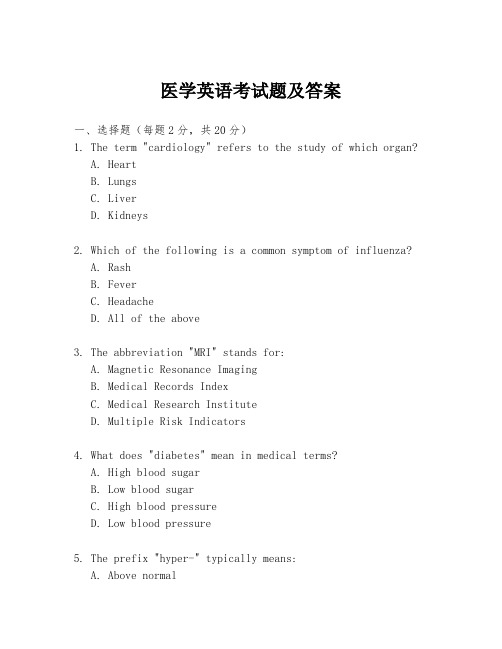
医学英语考试题及答案一、选择题(每题2分,共20分)1. The term "cardiology" refers to the study of which organ?A. HeartB. LungsC. LiverD. Kidneys2. Which of the following is a common symptom of influenza?A. RashB. FeverC. HeadacheD. All of the above3. The abbreviation "MRI" stands for:A. Magnetic Resonance ImagingB. Medical Records IndexC. Medical Research InstituteD. Multiple Risk Indicators4. What does "diabetes" mean in medical terms?A. High blood sugarB. Low blood sugarC. High blood pressureD. Low blood pressure5. The prefix "hyper-" typically means:A. Above normalB. Below normalC. ExcessiveD. Deficient6. Which of the following is a type of cancer?A. MelanomaB. BronchitisC. PneumoniaD. Asthma7. The term "anemia" is used to describe a condition where there is:A. Too much red blood cellsB. Too few red blood cellsC. Too much white blood cellsD. Too few white blood cells8. "Hemoglobin" is a protein in red blood cells that carries:A. OxygenB. Carbon dioxideC. GlucoseD. Water9. Which of the following is a method for measuring blood pressure?A. StethoscopeB. SphygmomanometerC. OtoscopeD. Ophthalmoscope10. The suffix "-itis" usually indicates:A. InflammationB. TumorC. CongestionD. Degeneration答案:1. A2. D3. A4. A5. A6. A7. B8. A9. B 10. A二、填空题(每空1分,共10分)1. The medical term for a break in the skin is a(n) _______.2. The study of the heart and its diseases is known as_______.3. A(n) _______ is a medical professional who specializes in the diagnosis and treatment of diseases of the eye.4. The process of identifying the cause of a disease iscalled _______.5. A person who has a fear of needles is said to have a(n)_______.6. The medical term for a surgical incision is a(n) _______.7. The term "hypertension" refers to _______ blood pressure.8. The abbreviation "HIV" stands for Human _______ Virus.9. The medical term for the removal of fluid from a bodycavity is _______.10. The study of the structure of the body is called _______.答案:1. Laceration2. Cardiology3. Ophthalmologist4. Diagnosis5. Trypanophobia6. Incision7. High8. Immunodeficiency9. Aspiration10. Anatomy三、简答题(每题5分,共30分)1. Explain the difference between a virus and a bacterium.2. What is the function of the thyroid gland?3. Describe the process of blood clotting.4. What is the role of insulin in the body?5. What are the symptoms of a common cold?6. How does the respiratory system work?答案:1. A virus is a small infectious agent that can only replicate inside the living cells of an organism, while a bacterium is a single-celled microorganism that can exist independently and can be beneficial, neutral, or harmful to humans.2. The thyroid gland is a butterfly-shaped gland located in the front of the neck that produces hormones regulating the body's metabolism.3. Blood clotting is a complex process that involves platelets and clotting factors to prevent excessive bleeding when a blood vessel is injured.4. Insulin is a hormone produced by the pancreas that regulates the amount of glucose in the blood, allowing cells to take in glucose from the bloodstream for energy.5. Symptoms of a common cold include a runny nose, sorethroat, coughing, sneezing, and sometimes fever.6. The respiratory system works by taking in oxygen from the air, which is then transported to the blood via the lungs,and expelling carbon dioxide from the body through exhalation.四、翻译题(每题5分,共20分)1. 将“急性阑尾炎”翻译成英文。
医学英语基础医学
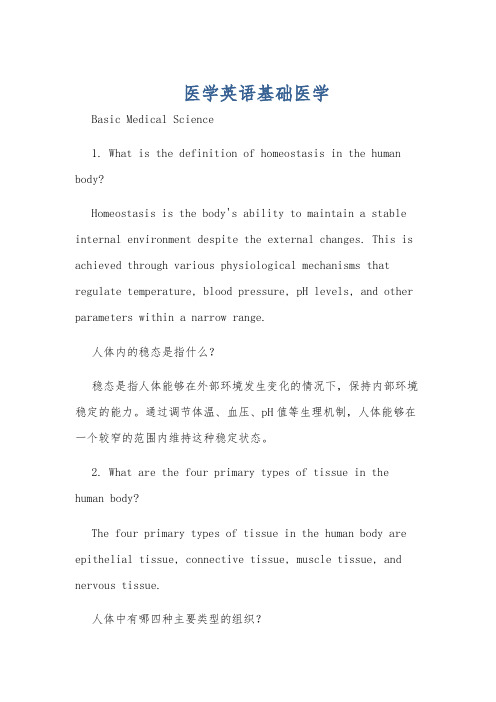
医学英语基础医学Basic Medical Science1. What is the definition of homeostasis in the human body?Homeostasis is the body's ability to maintain a stable internal environment despite the external changes. This is achieved through various physiological mechanisms that regulate temperature, blood pressure, pH levels, and other parameters within a narrow range.人体内的稳态是指什么?稳态是指人体能够在外部环境发生变化的情况下,保持内部环境稳定的能力。
通过调节体温、血压、pH值等生理机制,人体能够在一个较窄的范围内维持这种稳定状态。
2. What are the four primary types of tissue in the human body?The four primary types of tissue in the human body are epithelial tissue, connective tissue, muscle tissue, and nervous tissue.人体中有哪四种主要类型的组织?人体中的四种主要类型的组织包括上皮组织、结缔组织、肌肉组织和神经组织。
3. What is the function of the respiratory system?The respiratory system is responsible for the exchangeof oxygen and carbon dioxide between the body and the environment. It also helps regulate the body's pH and plays a role in vocalization and olfaction.呼吸系统的功能是什么?呼吸系统负责人体与环境之间的氧气和二氧化碳交换。
基础医学术语复习资料
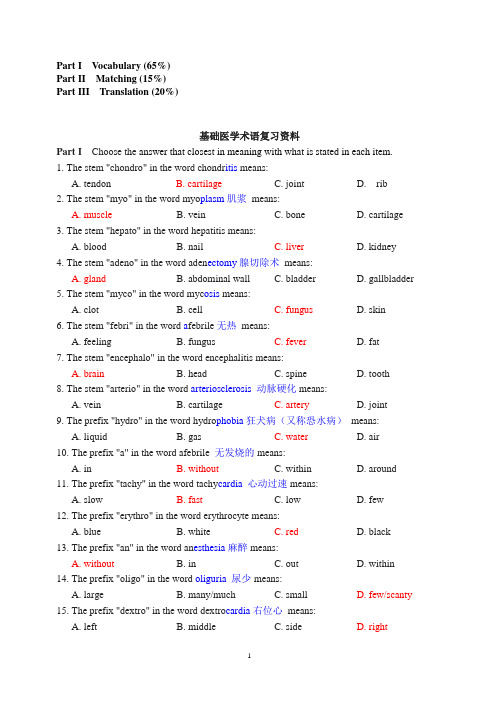
Part I Vocabulary (65%)Part II Matching (15%)Part III Translation (20%)基础医学术语复习资料Part I Choose the answer that closest in meaning with what is stated in each item.1. The stem "chondro" in the word chondr itis means:A. tendonB. cartilageC. jointD. rib2. The stem "myo" in the word myo plasm肌浆means:A. muscleB. veinC. boneD. cartilage3. The stem "hepato" in the word hepatitis means:A. bloodB. nailC. liverD. kidney4. The stem "adeno" in the word aden ectomy腺切除术means:A. glandB. abdominal wallC. bladderD. gallbladder5. The stem "myco" in the word myc osis means:A. clotB. cellC. fungusD. skin6. The stem "febri" in the word a febrile无热means:A. feelingB. fungusC. feverD. fat7. The stem "encephalo" in the word encephalitis means:A. brainB. headC. spineD. tooth8. The stem "arterio" in the word arteriosclerosis动脉硬化means:A. veinB. cartilageC. arteryD. joint9. The prefix "hydro" in the word hydro phobia狂犬病(又称恐水病)means:A. liquidB. gasC. waterD. air10. The prefix "a" in the word afebrile 无发烧的means:A. inB. withoutC. withinD. around11. The prefix "tachy" in the word tachy cardia心动过速means:A. slowB. fastC. lowD. few12. The prefix "erythro" in the word erythrocyte means:A. blueB. whiteC. redD. black13. The prefix "an" in the word an esthesia麻醉means:A. withoutB. inC. outD. within14. The prefix "oligo" in the word oliguria 尿少means:A. largeB. many/muchC. smallD. few/scanty15. The prefix "dextro" in the word dextro cardia右位心means:A. leftB. middleC. sideD. right16. If the foot is abducted外展, it is moved in which direction?A. InwardB. OutwardC. UpwardD. Downward17. The suffix "-osis" in the word derma tophy tosis脚气means:A. growingB. dilationC. droopingD. condition18. The suffix "-megaly" in the word hepatosplenomegaly肝脾肿大means:A. swellingB. softeningC. hardeningD. enlargement19. The suffix "-iasis" in the word nephrolithiasis肾结石means:A. suspension/fixationB. protrusion/swellingC. condition/presence ofD. growth/nourishment20. The suffix "-ectomy" in the word salpingo-oophorectomy输卵管卵巢切除术means:A. opening ofB. inspection ofC. suspension ofD. excision of切除21. The suffix "-centesis" in the word arthrocentesis关节穿刺术means:A. destruction ofB. puncture穿刺ofC. pertaining to 与有关D. originating in22. The suffix "-malacia" in the word chondro malacia软骨软化means:A. flowingB. hardeningC. softeningD. producing23. The suffix "-ar" in the word cardiovascular means:A. nourishment营养ofB. inspection检查ofC. pertaining toD. softening of24. The suffix "-phobia" in the word hydrophobia means:A. disease ofB. fear ofC. like ofD. opening of25. Which medical term means inflammation of appendix?A. appendi citis阑尾炎B. appenditisC. appendicopathyD. appendicosis26. Which medical term means removal of gallbladder?A. choledochectomy胆总管部分切除B. cholecystectomyC. cholelithectomyD. cholelithiasis胆结石27. Which medical term means process of viewing colon?A. colonostomyB. colonoscopeC. colonoscopy结肠镜检查D. coloscopy28. Which medical term means stomach pain?A. duodenalgiaB. Gingivalgia牙龈痛C. enteralgiaD. gastralgia29. Which medical term means surgical repair of stomach?A. gastroplasty胃形成术B. gastr otomyC. gastr ectomyD. Gastr ostomy胃造口30. Which medical term means pertaining to the third section of the small intestines?A. cuodenalB. ilealC. cecalD. jejuna31. Which medical term means inflammation of the rectum and anus?A. anitisB. sigmoiditisC. proctitisD. rectitis32. Which medical term means slow digestion?A. tachypepsiaB. dyspepsiaC. apepsiaD. brady pepsia33. Which medical term means excessive eating?A. polyphagiaB. tachyphagia速食癖C. dysphagia吞咽困难D. polypepsia34. Which medical term means abnormal appetite?A. dyspepsia消化不良,胃弱B. dys orexia食欲障碍C. dysphagiaD. dysprandial35. A _____is a small tumor on a stem attachment.A. polyp息肉B. pyrosisC. menenaD. denture36. The medical term for frequent, watery bowel movements水汪汪的大便is:A. cachexia恶病质,精神萎顿B. diarrheaC. Emesis呕吐D. Hematochezia便血37. NerveA. nephroB. NeuroC. UroD. nuero38. EyeA. orthoB. BioC. OphthalmoD. audio39. IntestineA. gastroB. GynecoC. EnteroD. carcino40. BloodA. hepatoB. HemoC. CardioD. gyneco41. LifeA. rhinoB. AdenoC. BioD. lifo42. HeadA. cephaloB. CytoC. CerebroD. gnoso43. StomachA. enteroB. GenoC. GastroD. stomato44. GlandA. arthroB. EnteroC. AdenoD. geno45. Match the following words to their definitions:bidA. DropsB. TabletC. Every hourD. Twice a day (every 12 hours)46. NeckA. cervicoB. thoracoC. thyroD. circo47. SkullA. cerebroB. OsteoC. MycloD. cranio48. FemaleA. gynecoB. HysteroC. LeukoD. hemato49. EarA. audioB. SonoC. OtoD. oro50. LiverA. hematoB. LactoC. HepatoD. patho51. TissueA. genoB. HematoC. GlycolD. histo52. TumorA. scopoB. oncoC. tomoD. cephalo53. CancerA. cardioB. costoC. CarcinoD. adeno54. The technique of graphically recording the electrical waves within the heart is called:A. EmbolismB. Electrocardi ogramC. EchocardiogramD. Ultrasound55. Which of the following indicates abnormally low heart rate?A. TachycardiaB. Bradycardia 心动过缓C. Heart attackD. Aneurysm 动脉瘤56. What is the meaning for the suffix algia?A. painB. soreC. tenderD. moist57. The term "lithi asis" meansA constriction of tissueB dissolvingC abnormal condition of stonesD penetrating a cavityE stretching of tissue58. Which of the following terms means drainage from the nose?A. Rhinolalia鼻音B. Rhinomycosis鼻真菌病C. Rhinorrhea鼻液溢D. Rhinorrhaphy鼻缝术59. Inflammation of a sweat gland is known asA colitis结肠炎B fasciitis筋膜炎C hidradenitisD pimelitis脂肪组织炎60. Which of the following terms refers to pain?A .Arthralgia B. Di plopia复视 C. Dysplasia发育不良D. Hemi plegia偏瘫61. Which of the following is the CORRECT spelling for the plural of bronchus?A. BronchusesB. BronchiiC. BronchiD. Bronchae62. Which of the following is the plural form of the medical term that means chest?A. AlveoliB. ApicesC. ThoracesD. Pleurae63. Instructions to take a medication "pc" meansA. at bedtimeB. before mealsC. after mealsD. every morning64. A patient scheduled for echoencephalography will undergo a study of which of the following?A. AbdomenB. BrainC. HeartD. Lungs65. Which of the following physicians specializes in treating patients with diseases of the liver?A .Hematologist B. Hepatologist C. Nephrologist D. Oncologist66. Cyto as in cytotoxic means_________.A. fatB. smoothC. blueD. cell67. Myo- as in myocardium refers to _________:A. brainB. myoptic nerveC. feetD. muscle68. Neuro as in neuroanatomy means_________.A. nerveB. newC. digestive systemD. endocrine system69. Kary/o as in karyoblast means __________.A. cellB. karaokeC. nucleusD. illness70. Leuk/o as in leukocytosis means___________.A. whiteB. limpidC. blackD. sickle-shaped71. V asculo- in vascular and vasculitis, vascularity means_________.A. muscleB. boneC. vesselD. heart72. Histo/o as in histogenesis means__________.A. filmB. timeC. tissueD. yellow73. Leuko- as in leukemia and leukocyte means:A. greenB. whiteC. redD. yellow74. Path/o as in pathology means ____________.A. withinB. purpleC. excisedD. disease75. Colo- as in colitis and colectomy means__________.A. liverB. intestineC. colonD. rectum76. –oma as in fibroma and thymoma means__________.A. tumorB. diseaseC. cancerD. disorder77. G astr/o as in gastritis and gastralgia means___________.A. gasB. airC. stomach.D. sugar78. Brady- as in bradypnea means____________.A. fastB. irregularC. prolongedD. slow79. Glyc/o as in glycogenesis means___________ .A. sugarB. Pus.C. fatD. enzyme80. Prote/o as in protelysis means___________.A. sugarB. starchC. proteinD. water81. Tachy- as in tachycardia means___________.A. A slowing downB. IrregularC. Fast or rapidD. Malignant82. -logy as in bacteriology means__________.A. medullaB. informationC. the study ofD. division83. Viscer/o as in viscerogenic means__________.A. cut openB. internal organsC. exoskeletonD. relate to84. Cyano as in Cyanosis and cyanoderma means_________.A. blueB. whiteC. cyanideD. large85. Reticul/o as in reticular means_________.A. restB. networkC. formD. branch86. Onc/o as in oncology means_________.A. coldB. cancerC. tumorD. deadly87. Endo- as inendotoxin and endocrinology meansA. innerB. outerC. upperD. lower88. Lip/o as in lipoid means__________.A. whiteB. fatC. roughD. soft89. Xantho as in xanthoderma means__________.A. yellowB. brownC. antiD. reversed90. Eti/o as in etiology means__________.A. systemB. science ofC. causeD. history91. Dys- as in dysplasia means________.A. twoB. difficultC. easyD. forked92. Hypo- as in Hypoventilation means________.A. below, incompleteB. over, outsideC. throughD. inside, within93. Chrom/o as in chromocyte means_________.A. silverB. colorC. brittleD. shiny94. –rhea as in diarrhea means_________.A. dischargeB. science ofC. painD. history95. Sarco- as in sarcoadenoma means__________.A. flesh, connective tissueB. solidC. opaqueD. forked96. -emia as in anemia means_________.A. blood ConditionB. deficiencyC. excess ofD. death of97. -pnea as in dyspnea means __________A. breakB. breathingC. swallowingD. circulation98. Scler/o as in Sclerosis and scleroderma means__________.A. hardeningB. contractionC. expandingD. malignancy99. Bio- as in biology and antibiotics means__________.A. bicepsB. abiosisC. living thingsD. amorphous 100. Cardio- or cardi- in endocarditis and myocardial means________.A. brainB. stomachC. intestineD. heart 101. -megaly as is in hepatomegaly means_________.A. multiplyB. ablationC. enlargementD. diseased 102. -plasia means:A. formation, development or growth.B. repairing of, suturing.C. metastasizing of a tumor.D. condition.103. -cele as is in Cystocele means____________.A. cellB. chestC. cavityD. swelling, protrusion 104. -itis as in hepatitis and Colitis means___________.A. itchingB. burningC. scalyD. inflammation 105. Phag/o as in phagocyte means__________.A. eat or ingestB. attractingC. originD. gland106. Bluish discoloration of the skin__________.A. cyanosisB. edemaC. ciliumD. effusion107. The medical term for headache__________.A. cephalgiaB. cyanosisC. migraineD. concussion 108. Red blood cell___________.A. lymphocyteB. eosinophilC. leukocyteD. erythrocyte 109. An agent that causes disease___________.A. phagocyteB. proteaseC. prophylaxisD. pathogen 110. Blood in the urine___________.A. uremiaB. hematocritC. hemostasisD. hematuria 111. Erythrocytes are ____________.A. white blood cells.B. red blood cells.C. benign tumor cells.D. also known as Leukocytes. 1127. Hemiplegia _____________.A. compound made of many subunitsB. paralysis of one side of the bodyC. Partial state of unconsciousnessD. pertaining to both sides of the body 113. Melanocyte______.A. scanty menstrual flowB. loss of color in the skinC. dark-colored cellD. cell with yellow color114. Endoparasite_____.A. parasite that lives inside the bodyB. toward the leftC. endbrainD. parasite that lives outside of the body 115. Ribosomes ____________.A. organelles that manufacture energy from foodB. organelles that manufacture proteinC. genetic materialD. energy compound of the cell116. Homeostasis ___________.A. building phase of metabolismB. state of internal stabilityC. fibrous protein in connective tissueD. breakdown phase of metabolism117. Reticulocyte _______________.A. inflammation of a glandB. enzyme that digestsC. fibrous tumorD. cell containing a network118. Polymorphic ____________.A. attracting waterB. having many formsC. nipplelike projectionD. wasting of tissue119. Hypoglycemic ____________.A. having low blood sugarB. enzyme that digests starchC. immature white blood cellD. fatlike120. Thoracotomy ____________.A. pertaining to the forearmB. loss of sensation in the extremitiesC. incision through the abdominal wallD. incision into the chest121. Dactylospasm ___________.A. cramp of a finger or toeB. excess number of fingers or toesC. congenital absence of a footD. surgical puncture of the abdomen122. Microlith _______________.A. very small stoneB. study of tumorsC. disease involving hardening of the skinD. study of poisons123. Dyspnea ______________.A. dryness of the skinB. malignant tumor of a glandC. painful or difficult breathingD. accumulation of fluid124. Hemorrhage _____________.A. droppingB. profuse flow of bloodC. narrowingD. ectasia125. Nephritis ______________.A. pathogens in the bloodB. wound or injuryC. disease characterized by enlargement of the extremitiesD. inflammation of the kidneyPart II C hoose the correct medical term from the list below that matches the corresponding definition,1. acute myocardial infarction A.冠状动脉主支架术2. primary coronary stenting B.急性心肌梗死3. angioplasty C.血恃成形术4. prospective study D.冠状动脉内支架5. intracoronary stent E.前贍性研究6. high pressure deployment A.阿司匹林7.adjunctive B 噻氯匹定疗法8. a spirin C. 辅助的9. t iclopidine therapy D. 华法令钠10. Coumadin F. 高压展开术11. prc-dischargc A. 支架血栓形成12. angiography B. 血管造影术13. stent implantation C. 支架植入14. stent thrombosis D. 血管造影(照片〉15. angiograms E. 出院前16. slow-flow phenomenon A. 左心室的17. left ventricular B. 血流缓慢现象18. ejection fraction C. 射血分数19. mortality D. 不良临床结局20. adverse clinical outcome E. 死亡率21. spirometry A. 鼻病毒22. pneumothorax B. 鼻黏膜23. dyspnea C. 呼吸困难24. nasal mucosa D. 呼吸測量法25. rhinovirus E. 气胸26. laryngorhinootology A.耳鼻喉科学27. glottoJogy B. 舌学28. tracheal intubation C. 纤维支气哲镜29. fiberoptic bronchoscopy D. 肺切除术30. p ulmonectomy E. 气管插管31 nasal mucosa A. 胸膜炎32 pneumocyte B. 肺泡炎33. alveolitis C與粘膜34. pleurisy D. 肺细胞35. dentoalveolitis E. 牙槽炎Part II. Translate the following into Chinese1、Physicians have used newly discovered organic chemicals successfully to treat malaria, typhoid , dysentery, rheumatoid arthritis.医生们采用新发现的有机药物治疗疟疾、伤寒、赤痢、风湿性关节炎。
基础医学英语术语复习题
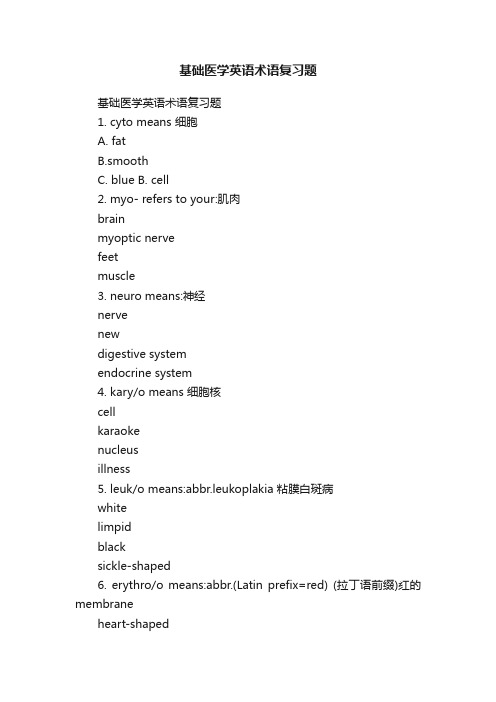
基础医学英语术语复习题基础医学英语术语复习题1. cyto means 细胞A. fatB.smoothC. blue B. cell2. myo- refers to your:肌肉brainmyoptic nervefeetmuscle3. neuro means:神经nervenewdigestive systemendocrine system4. kary/o means 细胞核cellkaraokenucleusillness5. leuk/o means:abbr.leukoplakia 粘膜白斑病whitelimpidblacksickle-shaped6. erythro/o means:abbr.(Latin prefix=red) (拉丁语前缀)红的membraneheart-shapedredbrown7. histo/o means: 组织、荚膜组织胞浆菌病filmtimetissueyellow8. melano means:blackdiseasedmalignantcancer9. path/o means: 疾病withinpurpleexciseddisease10. somat/o means: 【医】[=somatostatin]生长激素抑制素,生长抑素,生长激素释放抑制因子extremitybodytissuenerve11. Endo means: abbr.endoglycosidase 内切糖苷酶endo 内ENDO abbr.1.endomorphin 内变质作用2.endonuclease 核酸内切酶3.endoscopic harvest 内镜检查获取(标本)4.endothelin 内皮素5.endotoxemia 内毒素血症6.endotoxin (细菌)内毒素7.endovascular 血管内的Above.Below.Within.Fat.12. Thromb/o means:【医】[=thrombus]血栓To throb.To divide.To clot.To dry out.13. Brady- means:徐缓迟钝Fast.Irregular.Prolonged.Slow.14. Salping/o means .输卵管Fallopian tube.Pus.Polyp.Flesh, connective tissue.15. Onych/o meansTesticle.The same as Orchi/o.Single, one.Nail.16. Tachy- (as in tachycardia心动过速) means:速快速A slowing downIrregularFast or rapidMalignant17. andro means: 【医】[=androsterone]雄甾酮above, overhumanthroughmale18. viscer/o means: 内脏cut openinternal organsexoskeletonrelate to19. cyano 氰基bluewhitecyanidelarge20. gno/o means:smallknowledgescience ofbranch21. onc/o means:abbr.1.oncogene 致癌基因;肿瘤基因Onc abbr.oncofetal 癌胚的oldcancertumordeadly22. iatr/o means:hirsuteiodinePhysician内科医生, medicine医学cold23. lip/o:whitefatroughsoft24. xantho means:yellowbrownantireversed25. eti/o (as in etiology): 病因学病源论systemscience ofcausehistory26. dys- means: 困难的有病的twodifficulteasyforked27. hypo- means: 在··之下次亚于不足从属于below, incomplete over, outsidethroughinside, within28. chrom/o means: 色silvercolorbrittleshiny29. rhabd/o means: 主杆杆状的rod-shapedscience ofrapidhistory30. sarco means:flesh, connective tissuesolidopaqueforked31. -emia means:血条件Blood Condition. Deficiency.Excess of.Death of32. -pnea means :Break.Breathing.Swallowing.Circulation.33. -stenosis means:阻塞物Hardening. Constriction. Expanding.Malignancy.34. -ostomy means:Cut into or incision. Ablation.Enlargement.Create an artificial opening.35. -otomy means:Cut into or incision.Ablation.Enlargement.Create an artificial opening.36. -megaly means:abbr.megaloblastic anemia 巨幼红细胞性贫血Multiply.Enlargement.Diseased.37. -plasia means:Formation, development or growth.Repairing of, suturing.Metastisizing of a tumor.Condition.38. -cele means:肿胀浮肿Cell.Chest.Cavity.Swelling, protrusion.39. -itis means:发炎炎症Itching.Burning.Scaly.Inflammation.40. The Suffix "pepsia" refers to:Chest musclesThe nervous systemDigestionHearing41. Scraping away擦伤of the skin or mucous粘液的membrane膜by friction. 皮肤擦伤处ContusionAbrasionCarbuncle42. Surgical repair of the cornea眼角膜. 角膜成型术KeratonomyCorneoplastyKeratoplastyKeratoscopy43. Inflammation of the tympanic鼓膜的membrane. 鼓膜炎AnotiaLabyrinthitisMeniere's diseaseMyringitis [,mirin'd?aitis】44. Bluish discoloration 变色of the skin. 苍白病CyanosisEdemaCiliumEffusion45. Disease of the heart muscle. 心肌病CardioplexyCardiopathyCardiomyopathyMyopathy46. Removal of the gallbladder.胆囊胆囊切除术CystectomyCholedochectomyCholecystectomyCholangiography47. Painful menstruation月经. 痛经AmenorrheaHypermenorrheaDyspareuniaDysmenorrhea48. Above the pubic阴部的耻骨的bones. 耻骨弓上的PerineumTransperinealInferiopubicSuprapubic49. Enlargement of a finger or toe. 巨蹼分离术Dactylomegaly[,d?ktil?u'meɡ?li]AnkylosisDiaphysisKyphosis50. The medical term for headache. 头痛CephalgiaCyanosisMigraineConcussion51. Red blood cell. 红细胞LymphocyteEosinophilLeukocyteErythrocyte52. An infection with the fungus真菌霉菌Candida念珠菌. 霉菌性口炎鹅口疮ThrushMacrophageTiterImpetigo53. Disease of a lymph淋巴结node瘤. 淋巴结病LymphadenopathyAdenoidopathyAdenectomyAdenitis54. A woman who has never been pregnant.NulligravidaPrimigravidaNulliparaPrimipara55. Accumulation of blood in a joint. 关节出血症HemarthrosisHematuriaHematosisHepatitis56. Protrusion 突出of the eyeballs. 眼球突出ExophthalmosOphthalmusExotropiaOpacification57. Abnormal widening扩张of the bronchi支气管. 支气管扩张BronchiolitisBronchiectasisBronchiolvescularAsthma58. Membranes that cover the brain and spinal脊柱的cord. 脑膜髓膜MeningesCerebrospinal fluidMeningitisMyasthenia59. An agent that causes disease. 病菌病原体PhagocyteProteaseProphylaxisPathogen60. Blood in the urine小便. 血尿症UremiaHematocritHeomstasisHematuria61. Erythrocytes are:红细胞White blood cells.Red blood cells.Benign tumor cells.Also known as Leukocytes.62. The superior vena cava腔静脉is:The major artery that supplies the trunk and legs with blood. Located in the lower trunk of the body.Located in the lower part of the neck..位于颈部的下半部分Connected to the celiac trunk.63. The common carotid颈动脉artery动脉is:In the upper portion of the thigh.Beneath the Medulla OblongataAt the base of the neck.Inside the Cerebellum64. The carotid artery branches into the:Internal carotid artery; the external carotid artery. Supratrochlear, supertrochlear..Inferior thoracic, superior thoracic.Common iliac artery, external iliac artery..65. The integumentary外皮的包皮的system does NOT include the: Liver.Hair.Nails.Mouth.66. The right ventricle脑室心室is the:One of the primary heart valves.Large lower cavity of the heart.大型低腔心脏Left upper portion of the heart..Right upper portion of the heart67. The septum隔膜:Divides the heart lengthwise纵长的纵向的into left and right. separates the right and left nasalcavity鼻腔的.The thin wall which separates one alveolus肺泡from another.All of the above.68. The cervical颈部的lymph淋巴nodes 颈部淋巴结are located: Near the groin.In the armpit.Near the stomach.In the neck.69. Inguinal腹股沟的means:Near the heart.In the groin腹股沟area.The region of the small intestines.The lower leg.70. Axillary lymph glands腋窝淋巴结are located:In the neck.In the groin.In the upper leg.In the armpit腋窝.71. A bronchoplasty支气管成形术is the surgical repair of the bronchus. TrueFalse72. A fistula瘘管is tube-like管类passage between two organs, for example, between the kidney肾脏and an organ of the digestive system.TrueFalse73. A sigmoidoscopy乙状结肠镜术is an endoscopic内窥镜的examination of a part of the small intestines肠.TrueFalse74. The term percutaneous经皮的is derived from the greek "to cut a (small) incision (through the skin)"TrueFalse75. Ablation消融切除refers to the procedure of expanding a vessel血管(e.g., an artery) using a balloon.TrueFalse76. A Laryngostomy侯造口术is a surgical incision (opening) from the neckinto the larynx喉.TrueFalse77. Ablution沐浴means to destroy or remove.TrueFalse78. A neurorrhaphy神经缝合术is the separating of a blood vessel血管.TrueFalse79. Osteoclasis骨折is the surgical breaking of a bone.TrueFalse80. Costectomy肋骨切除术is the surgical repair of the coccyx 尾骨.TrueFalseMatching: Matching the terms in each of following sets with their definitions and write the appropriate letter (a-e) to the left of each number:d 1. bilateral 双边的 a. compound made of many subunitsb 2. Hemiplegia半身不b. paralysis of one side of the body遂e 3. Quadrisect 四等分 c. Partial state of unconsciousnessa 4. Polymer聚合的 d. pertaining to both sides of the bodyc 5. Semicoma半昏迷 e. cut into four partsc 6. Melanocyte黑素细胞a. Scanty数量不足的menstrual月经的flowb 7. Leukoderma白变病 b. loss of color in the skind 8. xanthoocyte c. dark-colored celle 9. Adhesion粘连依附 d. cell with yellow colora 10. Oligomenorrhea月经稀发e. attachment of partsb 11. Sinistral用左手的 a. Parasite寄生虫that lives inside thebodyd 12. Ectoparasite皮外寄生虫b. toward the leftA 13. Endoparasite体内寄生虫c. Endbrain端脑终脑e 14. Mesencephalon中脑d. parasite that lives outside of the body_____c 15. telenephalon e. Midbrain中脑___________e 16. ytoplasm a. Organelles细胞器that manufacture energy from food_____c 17. DNA b. organelles that manufacture protein_____d 18. TP c. genetic material遗传物质_____b 19. Ribosomes核糖体 d. energy compound of the cell _____a 20. Mitochondria线粒体e. Fluid流体that fills the cell___b__ 21. Homeostasis动态平衡a. building phase of metabolism_____d _ 22. Catabolism异化作用分解代谢b. state of internal stability______ a 23. Anabolism合成代谢c. Fibrous纤维的protein in connectivetissue结缔体素_e____24. Adipose脂肪质的 d. Breakdown分解phase阶段ofCase Studies1. Esopha’geal spasm 食道痉挛This patient is a 53-year-old white female who has consulted 求助于for occasional episodes of dysphagia(吞咽困难) with moderate to severe tight, gripping pain in the mid-thorax. The onset is sudden following ingestion of food or beverage. The pain is retrosternal (胸骨后的) at first and then radiates to the cervical and dorsal regions. It is not improved by assuming a supine position(仰卧). There is no vomiting or dyspnea(呼吸困难). In the absence of other symptoms, esophageal spasm is suspected. If difficulties persist, fluoroscopy(荧光检查)with a barium9(钡)swallow will be done to rule out paraesophageal hiatal hernia.(食管旁食管旁裂孔疝)2. Pathology report-Cervical and Endometrial BiopsiesTwo separate uterine(子宫的) specimens are submitted. Specimen 1 is a cervical biopsy(宫颈活检)1.3cm in maximum width by 1.1 cm thickness.The exocervical (外子宫颈的) surface is smooth. There are numerous areas of mild to moderate dysplasia(发育异常). Slide F shows the endocervix(宫颈内膜) displaying metaplasia by hyperchromatic cells(高染色细胞) involving almost the entire thickness of the epithelium. No area of invasion of the basement is observed. There is chronic inflammation(慢性炎症).Specimen 2 consists of multiple fragments of endometrial tissue.Examination show a proliferative(增生性的) type of endometrium(子宫内膜). No malignancy is seen.3. Laparoscopy(腹腔镜检查)and laparotomy(剖腹手术)The patient was taken to the operating room under general anesthetic. A pneumoperitoneum (气腹) was performed for usual laparoscopy procedure。
基础医学英文大题

人体解剖学1.Describe the valves of the heart, correlating their structure with function.2.A good way to test your knowledge of the relationships of blood vessels and the structure of the heart is to trace blood from one part of the body to another, naming all vessels, heart chambers, and valves in proper sequence. Practice on the following and then work out some more for yourself.a) From the inferior mesenteric vein to the left coronary artery.b) From the dorsal venous arch of the foot to the right pulmonary artery.c) From the ascending aorta to the coronary sinus.d) From the transverse sinus of the cranial cavity to the right atrium.e) From the left ventricle to the circle of Willis--give alternate routes, if any.f) From the arch of the aorta to the right ulnar artery.g) From the dorsal venous arch of the hand to the right atrium.组织胚胎学1.Describe the ultrastructure and distribution of the 3 types of capillaries.pared the different structure between the artery and vein.pared the structure between endocardium and epicardium.生理学1.Term: Premature systole; Atrioventricular delay;Cardiac cycle: Stroke volume(SV)Cardiac output(CO) Ejection fraction Frank-Starling mechanism; Blood pressure;Central venous pressure Baroreceptor reflex.2.Describe in sequence the events that occur in the heart during cardiac cycle.3.List the factors that affect heart pumping and the effect of each.4.List the factors affecting arterial blood pressure.5.Outline the neural mechanisms that control arterial blood pressure and heart rate, including the receptors, afferent and efferent pathways, central integrating pathway, and effector mechanisms involved. the principal hormones that affect arterial blood pressure, and know the physiologic role of each.病理学1.Definition & classification (WHO,2000) of lymphoma, definition of leukemia.2.What is Ph1 chromosome? And chloroma?3.Describe the base changes of atherosclerosis, hypertension, rheumatism.4.What is CHD? How many types? What are the pathologic changes & the consequences?pare the difference between SBE &ABE.6.What is the valvestenosis? And the valve incompetence?7.Describe the outcome of congestion.8.What is thrombosis, embolism, and infarction? Their relationship?病理生理学1.Term: Shock; Heart failure; Multiple system organ dysfunctions; Systemic inflammatory response syndrome; Congestive heart failure; Ventricular remodeling; Concentric hypertrophy.2.The mechanisms for microcirculation stasis in stagnant hypoxia stage of shock.3.The compensatory effects in ischemic hypoxia stage of shock.4.The mechanisms of DIC in refractory stage of shock.5.What are the adaptive changes after heart pump dysfunction?6.Pathogenesis of decline of myocardial contractility and diastolic properties.7.What are the effects of cardiac pump dysfunction on the body?药理学1.Please describe the classification of antiarrhythmic drugs and 1-2 names of the representative drugs.2.Please describe the classification of anti-CHF drugs and 1-2 names of the representative drugs.3.Please describe the classification of antianginal drugs and 1-2 names of the representative drugs.4.Please describe the classification of antihypertensive drugs and 1-2 names of the representative drugs.。
- 1、下载文档前请自行甄别文档内容的完整性,平台不提供额外的编辑、内容补充、找答案等附加服务。
- 2、"仅部分预览"的文档,不可在线预览部分如存在完整性等问题,可反馈申请退款(可完整预览的文档不适用该条件!)。
- 3、如文档侵犯您的权益,请联系客服反馈,我们会尽快为您处理(人工客服工作时间:9:00-18:30)。
基础医学英语术语复习题1. cyto meansA. fatB.smoothC. blue B. cell2. myo- refers to your:A. brainmyoptic nervefeetmuscle3. neuro means:nervenewdigestive systemendocrine system4. kary/o meanscellkaraokenucleusillness5. leuk/o means:whitelimpidblacksickle-shaped6. erythro/o means:membraneheart-shapedredbrown7. histo/o means:filmtimetissueyellow8. melano means:blackdiseasedmalignantcancer9. path/o means:withinpurpleexciseddisease10. somat/o means:extremitybodytissuenerve11. Endo means:Above.Below.Within.Fat.12. Thromb/o means:To throb.To divide.To clot.To dry out.13. Brady- means:Fast.Irregular.Prolonged.Slow.14. Salping/o means .Fallopian tube.Pus.Polyp.Flesh, connective tissue.15. Onych/o meansTesticle.The same as Orchi/o.Single, one.Nail.16. Tachy- (as in tachycardia) means:A slowing downIrregularFast or rapidMalignant17. andro means: above, over humanthroughmale18. viscer/o means: cut openinternal organs exoskeletonrelate to19. cyanobluewhitecyanidelarge20. gno/o means: smallknowledge science ofbranch21. onc/o means: oldcancertumordeadly22. iatr/o means: hirsuteiodine physician, medicine cold23. lip/o:whitefatroughsoft24. xantho means: yellowbrownantireversed25. eti/o (as in etiology): systemscience ofcausehistory26. dys- means:twodifficulteasyforked27. hypo- means: below, incomplete over, outsidethroughinside, within28. chrom/o means: silvercolorbrittleshiny29. rhabd/o means:rod-shapedscience ofrapidhistory30. sarco means: flesh, connective tissue solidopaqueforked31. -emia means: Blood Condition. Deficiency.Excess of.Death of32. -pnea means : Break.Breathing.Swallowing.Circulation.33. -stenosis means: Hardening.Constriction.Expanding.Malignancy.34. -ostomy means:Cut into or incision.Ablation.Enlargement.Create an artificial opening.35. -otomy means:Cut into or incision.Ablation.Enlargement.Create an artificial opening.36. -megaly means:Multiply.Ablation.Enlargement.Diseased.37. -plasia means:Formation, development or growth. Repairing of, suturing. Metastisizing of a tumor. Condition.38. -cele means:Cell.Chest.Cavity.Swelling, protrusion.39. -itis means:Itching.Burning.Scaly.Inflammation.40. The Suffix "pepsia" refers to: Chest musclesThe nervous systemDigestionHearing41. Scraping away of the skin or mucous membrane by friction. ContusionAbrasionCarbuncleBullae42. Surgical repair of the cornea.KeratonomyCorneoplastyKeratoplastyKeratoscopy43. Inflammation of the tympanic membrane.AnotiaLabyrinthitisMeniere's diseaseMyringitis44. Bluish discoloration of the skin.CyanosisEdemaCiliumEffusion45. Disease of the heart muscle.CardioplexyCardiopathyCardiomyopathyMyopathy46. Removal of the gallbladder.CystectomyCholedochectomyCholecystectomyCholangiography47. Painful menstruation.AmenorrheaHypermenorrheaDyspareuniaDysmenorrhea48. Above the pubic bones.PerineumTransperinealInferiopubicSuprapubic49. Enlargement of a finger or toe. DactylomegalyAnkylosisDiaphysisKyphosis50. The medical term for headache. CephalgiaCyanosisMigraineConcussion51. Red blood cell.LymphocyteEosinophilLeukocyteErythrocyte52. An infection with the fungus Candida. ThrushMacrophageTiterImpetigo53. Disease of a lymph node. LymphadenopathyAdenoidopathyAdenectomyAdenitis54. A woman who has never been pregnant. NulligravidaPrimigravidaNulliparaPrimipara55. Accumulation of blood in a joint. HemarthrosisHematuriaHematosisHepatitis56. Protrusion of the eyeballs.ExophthalmosOphthalmusExotropiaOpacification57. Abnormal widening of the bronchi.BronchiolitisBronchiectasisBronchiolvescularAsthma58. Membranes that cover the brain and spinal cord. MeningesCerebrospinal fluidMeningitisMyasthenia59. An agent that causes disease.PhagocyteProteaseProphylaxisPathogen60. Blood in the urine.UremiaHematocritHeomstasisHematuria61. Erythrocytes are:White blood cells.Red blood cells.Benign tumor cells.Also known as Leukocytes.62. The superior vena cava is:The major artery that supplies the trunk and legs with blood. Located in the lower trunk of the body.Located in the lower part of the neck..Connected to the celiac trunk.63. The common carotid artery is:In the upper portion of the thigh.Beneath the Medulla OblongataAt the base of the neck.Inside the Cerebellum64. The carotid artery branches into the:Internal carotid artery; the external carotid artery. Supratrochlear, supertrochlear..Inferior thoracic, superior thoracic.Common iliac artery, external iliac artery..65. The integumentary system does NOT include the: Liver.Hair.Nails.Mouth.66. The right ventricle is the:One of the primary heart valves.Large lower cavity of the heart.Left upper portion of the heart..Right upper portion of the heart67. The septum:Divides the heart lengthwise into left and right. separates the right and left nasal cavity.The thin wall which separates one alveolus from another. All of the above.68. The cervical lymph nodes are located:Near the groin.In the armpit.Near the stomach.In the neck.69. Inguinal means:Near the heart.In the groin area.The region of the small intestines.The lower leg.70. Axillary lymph glands are located:In the neck.In the groin.In the upper leg.In the armpit.71. A bronchoplasty is the surgical repair of the bronchus. TrueFalse72. A fistula is tube-like passage between two organs, for example, between the kidney and an organ of the digestive system.TrueFalse73. A sigmoidoscopy is an endoscopic examination of a part of the small intestines.TrueFalse74. The term percutaneous is derived from the greek "to cut a (small) incision (through the skin)"TrueFalse75. Ablation refers to the procedure of expanding a vessel (e.g., an artery) using a balloon.TrueFalse76. A Laryngostomy is a surgical incision (opening) from the neck into the larynx.TrueFalse77. Ablution means to destroy or remove.TrueFalse78. A neurorrhaphy is the separating of a blood vessel.TrueFalse79. Osteoclasis is the surgical breaking of a bone.TrueFalse80. Costectomy is the surgical repair of the coccyx.TrueFalseMatching: Matching the terms in each of following sets with their definitions and write the appropriate letter (a-e) to the left of each number:1. bilateral a. compound made of many subunits2. hemiplegia b. paralysis of one side of the body3. Quadrisect c. Partial state of unconsciousness4. polymer d. pertaining to both sides of the body5. semicoma e. cut into four parts6. melanocyte a. scanty menstrual flow7. leukoderma b. loss of color in the skin8. xanthoocyte c. dark-colored cell9. adhesion d. cell with yellow color10. oligomenorrhea e. attachment of parts11. sinistral a. parasite that lives inside the body12. ectoparasite b. toward the left13. endoparasite c. endbrain14. mesencephalon d. parasite that lives outside of the body______ 15. telencephalon e. midbrain____________ 16. cytoplasm a. organelles that manufacture energy fromfood______ 17. DNA b. organelles that manufacture protein______ 18. TP c. genetic material______ 19. ribosomes d. energy compound of the cell______ 20. mitochondria e. fluid that fills the cell______ 21. homeostasis a. building phase of metabolism______ 22. catabolism b. state of internal stability______ 23. anabolism c. fibrous protein in connective tissueCase Studies1. Esopha’geal spasm 食道痉挛This patient is a 53-year-old white female who has consulted for occasional episodes of dysphagia(吞咽困难) with moderate to severe tight, gripping pain in the mid-thorax. The onset is sudden following ingestion of food or beverage. The pain is retrosternal (胸骨后的) at first and then radiates to the cervical and dorsal regions. It is not improved by assuming a supine position(仰卧). There is no vomiting or dyspnea(呼吸困难). In the absence of other symptoms, esophageal spasm is suspected. If difficulties persist, fluoroscopy(荧光检查)with a barium9(钡)swallow will be done to rule out paraesophageal hiatal hernia.(食管旁食管旁裂孔疝)2. Pathology report-Cervical and Endometrial BiopsiesTwo separate uterine(子宫的) specimens are submitted. Specimen 1 is a cervical biopsy(宫颈活检)1.3cm in maximum width by 1.1 cm thickness.The exocervical (外子宫颈的) surface is smooth. There are numerous areas of mild to moderate dysplasia(发育异常). Slide F shows the endocervix(宫颈内膜) displaying metaplasia by hyperchromatic cells() involving almost the entire thickness of the epithelium. No area of invasion of the basement is observed. There is chronic inflammation(慢性炎症). Specimen 2 consists of multiple fragments of endometrial tissue. Examination show a proliferative(增生性的) type of endometrium(子宫内膜). No malignancy is seen.3. Laparoscopy(腹腔镜检查)and laparotomy(剖腹手术)The patient was taken to the operating room under general anesthetic. A pneumoperitoneum (气腹) was performed for usual laparoscopy procedure per an infraumbilical (脐下的) incision. Visualization(造影,显影) of the abdominal viscera(内脏) was complicated by multiple small bowel (小肠)adhesions. The laparoscopy instruments were therefore withdrawn. Interrupted 3.0 Vicryl sutures(缝合线) were placed periumbilically(脐周的). An exploratory laparotomy (剖腹探查术)was then performed by means ofa midline incision.81. The term supine meansA. lying face downB. standing in the anatomic positionC. sittingD. lying face up82. The cervical region is the region of theA. heartB. armC. neckD. head83. A word that means the same as dorsal isA. anteriorB. inferiorC. posteriorD. superior84. the terms metaplasia and dysplasia refer toA. formation of cellsB. numbers of cellsC. size of cellsD. color of cells85. The phrase “adhesion were lysed”means thatA. parts were joined togetherB. joined parts were separatedC. parts were removedD. specimens were taken86. The term hyperchromatic meansA. excessively large in sizeB. excessively small in sizeC. deficient in colorD. containing excess color87. The term pneumoperitoneum refers toA. inflation of the thoracic cavityB. incision of the abdominal cavityC. inflation of the abdominal cavityD. incision of the pleural cavity。
